BTEC Level 5 Diploma: Understanding and Leading Change Report
VerifiedAdded on 2022/12/28
|17
|5264
|47
Report
AI Summary
This report delves into the critical aspects of understanding and leading change within organizations, with a specific focus on the impact of change on strategies and operations. It examines the experiences of prominent UK-based companies like Tesco, ASDA, and Barclays, evaluating how they adapted to challenges, particularly those arising from the COVID-19 pandemic. The report analyzes the role of leadership skills, internal and external drivers, and decision-making processes in effectively managing change. It also investigates various hindrances to change and the approaches leaders can adopt to facilitate it, providing a comprehensive overview of change management in the business context. The report explores the strategic responses of Tesco and ASDA, the internal and external factors affecting Barclays, and the obstacles faced by John Lewis plc, culminating in a detailed understanding of change management principles and their practical application in the business world. This report provides a valuable resource for students seeking insights into leading change and its impact on organizational success.
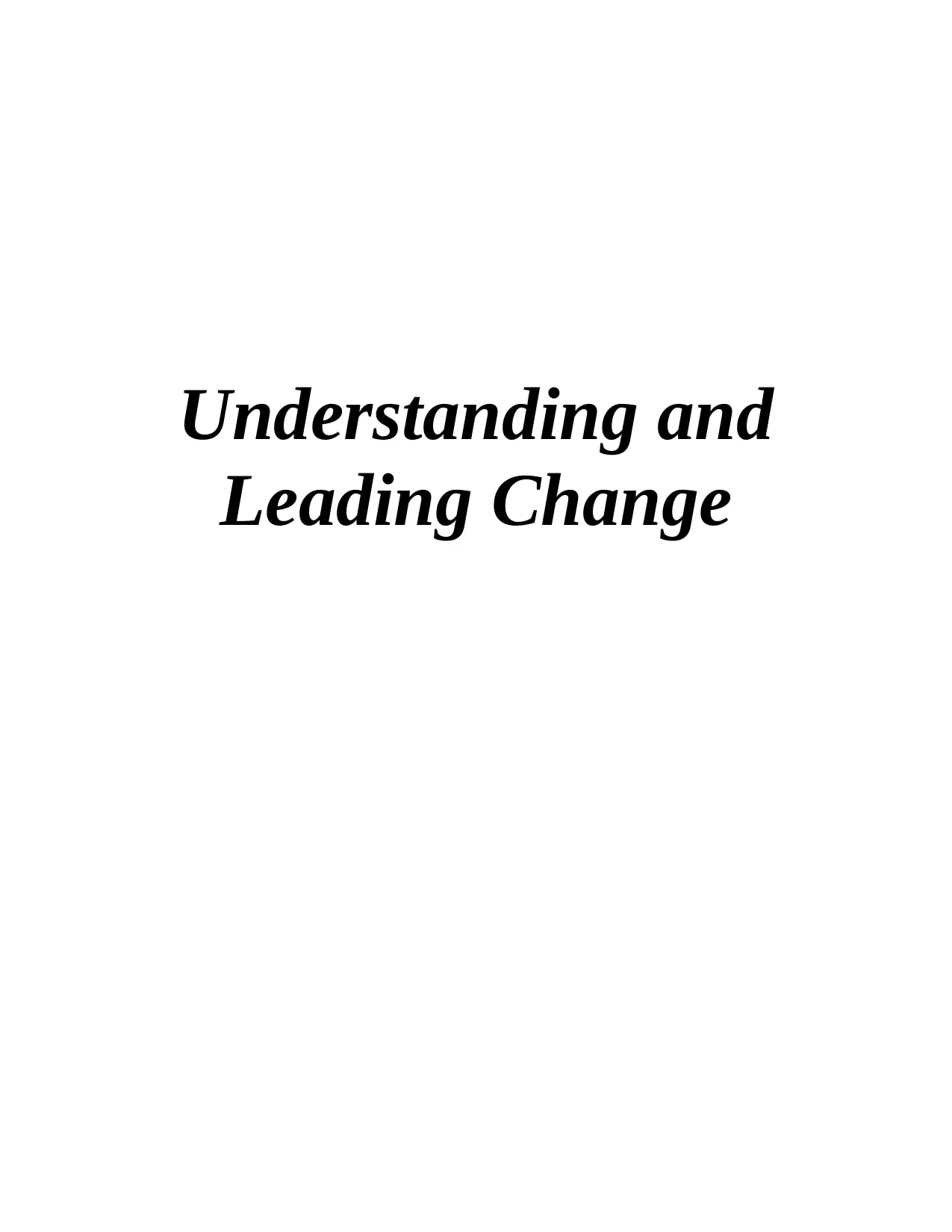
Understanding and
Leading Change
Leading Change
Secure Best Marks with AI Grader
Need help grading? Try our AI Grader for instant feedback on your assignments.
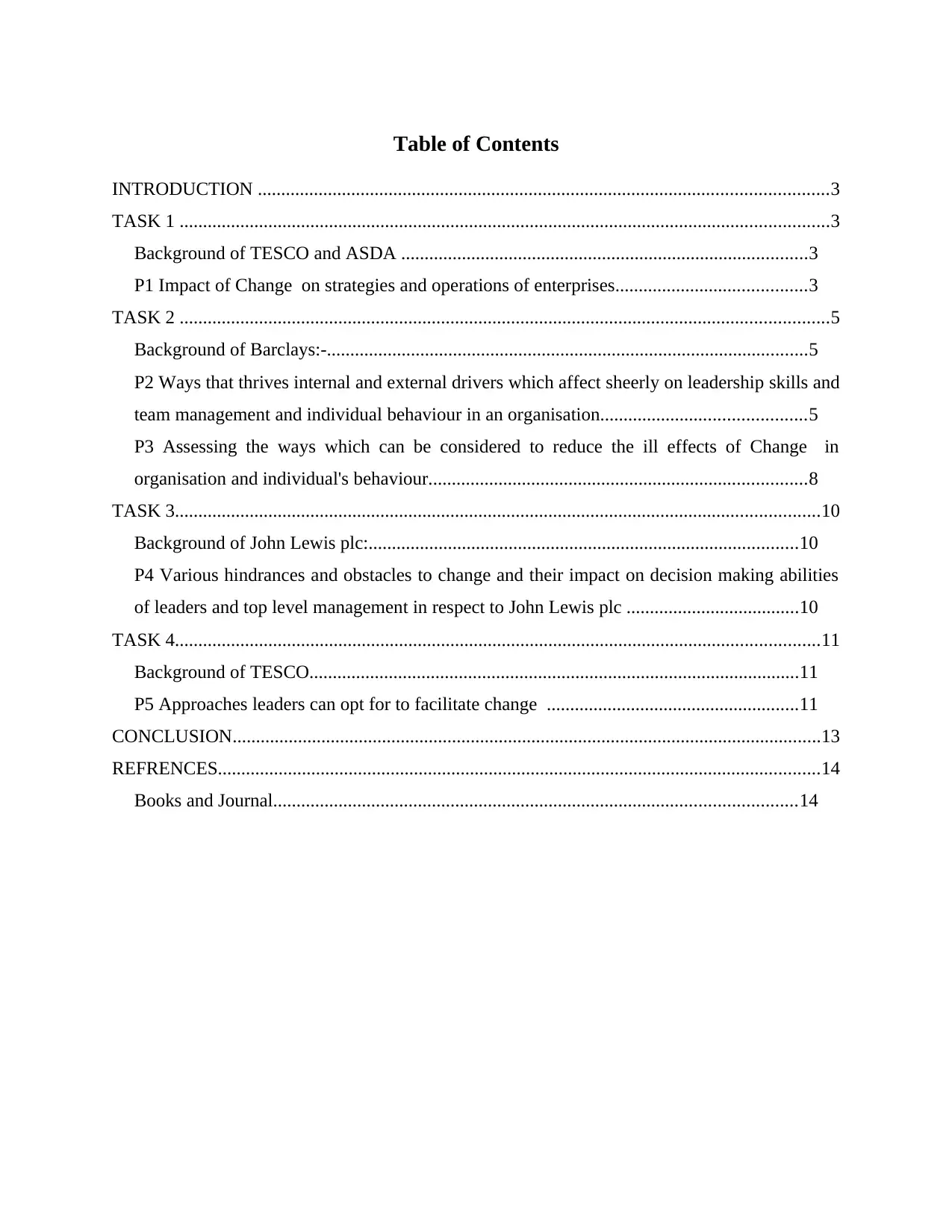
Table of Contents
INTRODUCTION ..........................................................................................................................3
TASK 1 ...........................................................................................................................................3
Background of TESCO and ASDA .......................................................................................3
P1 Impact of Change on strategies and operations of enterprises.........................................3
TASK 2 ...........................................................................................................................................5
Background of Barclays:-.......................................................................................................5
P2 Ways that thrives internal and external drivers which affect sheerly on leadership skills and
team management and individual behaviour in an organisation............................................5
P3 Assessing the ways which can be considered to reduce the ill effects of Change in
organisation and individual's behaviour.................................................................................8
TASK 3..........................................................................................................................................10
Background of John Lewis plc:............................................................................................10
P4 Various hindrances and obstacles to change and their impact on decision making abilities
of leaders and top level management in respect to John Lewis plc .....................................10
TASK 4..........................................................................................................................................11
Background of TESCO.........................................................................................................11
P5 Approaches leaders can opt for to facilitate change ......................................................11
CONCLUSION..............................................................................................................................13
REFRENCES.................................................................................................................................14
Books and Journal................................................................................................................14
INTRODUCTION ..........................................................................................................................3
TASK 1 ...........................................................................................................................................3
Background of TESCO and ASDA .......................................................................................3
P1 Impact of Change on strategies and operations of enterprises.........................................3
TASK 2 ...........................................................................................................................................5
Background of Barclays:-.......................................................................................................5
P2 Ways that thrives internal and external drivers which affect sheerly on leadership skills and
team management and individual behaviour in an organisation............................................5
P3 Assessing the ways which can be considered to reduce the ill effects of Change in
organisation and individual's behaviour.................................................................................8
TASK 3..........................................................................................................................................10
Background of John Lewis plc:............................................................................................10
P4 Various hindrances and obstacles to change and their impact on decision making abilities
of leaders and top level management in respect to John Lewis plc .....................................10
TASK 4..........................................................................................................................................11
Background of TESCO.........................................................................................................11
P5 Approaches leaders can opt for to facilitate change ......................................................11
CONCLUSION..............................................................................................................................13
REFRENCES.................................................................................................................................14
Books and Journal................................................................................................................14
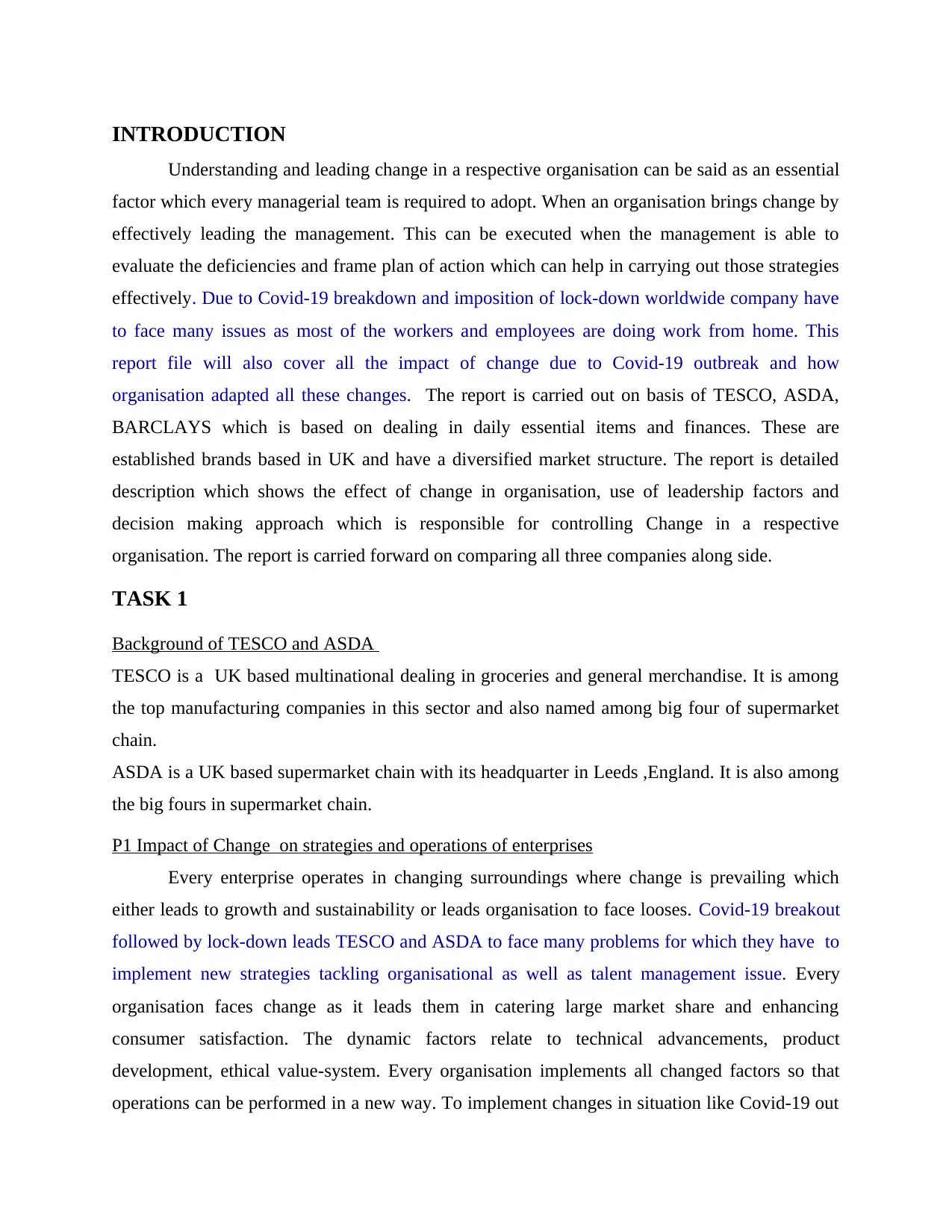
INTRODUCTION
Understanding and leading change in a respective organisation can be said as an essential
factor which every managerial team is required to adopt. When an organisation brings change by
effectively leading the management. This can be executed when the management is able to
evaluate the deficiencies and frame plan of action which can help in carrying out those strategies
effectively. Due to Covid-19 breakdown and imposition of lock-down worldwide company have
to face many issues as most of the workers and employees are doing work from home. This
report file will also cover all the impact of change due to Covid-19 outbreak and how
organisation adapted all these changes. The report is carried out on basis of TESCO, ASDA,
BARCLAYS which is based on dealing in daily essential items and finances. These are
established brands based in UK and have a diversified market structure. The report is detailed
description which shows the effect of change in organisation, use of leadership factors and
decision making approach which is responsible for controlling Change in a respective
organisation. The report is carried forward on comparing all three companies along side.
TASK 1
Background of TESCO and ASDA
TESCO is a UK based multinational dealing in groceries and general merchandise. It is among
the top manufacturing companies in this sector and also named among big four of supermarket
chain.
ASDA is a UK based supermarket chain with its headquarter in Leeds ,England. It is also among
the big fours in supermarket chain.
P1 Impact of Change on strategies and operations of enterprises
Every enterprise operates in changing surroundings where change is prevailing which
either leads to growth and sustainability or leads organisation to face looses. Covid-19 breakout
followed by lock-down leads TESCO and ASDA to face many problems for which they have to
implement new strategies tackling organisational as well as talent management issue. Every
organisation faces change as it leads them in catering large market share and enhancing
consumer satisfaction. The dynamic factors relate to technical advancements, product
development, ethical value-system. Every organisation implements all changed factors so that
operations can be performed in a new way. To implement changes in situation like Covid-19 out
Understanding and leading change in a respective organisation can be said as an essential
factor which every managerial team is required to adopt. When an organisation brings change by
effectively leading the management. This can be executed when the management is able to
evaluate the deficiencies and frame plan of action which can help in carrying out those strategies
effectively. Due to Covid-19 breakdown and imposition of lock-down worldwide company have
to face many issues as most of the workers and employees are doing work from home. This
report file will also cover all the impact of change due to Covid-19 outbreak and how
organisation adapted all these changes. The report is carried out on basis of TESCO, ASDA,
BARCLAYS which is based on dealing in daily essential items and finances. These are
established brands based in UK and have a diversified market structure. The report is detailed
description which shows the effect of change in organisation, use of leadership factors and
decision making approach which is responsible for controlling Change in a respective
organisation. The report is carried forward on comparing all three companies along side.
TASK 1
Background of TESCO and ASDA
TESCO is a UK based multinational dealing in groceries and general merchandise. It is among
the top manufacturing companies in this sector and also named among big four of supermarket
chain.
ASDA is a UK based supermarket chain with its headquarter in Leeds ,England. It is also among
the big fours in supermarket chain.
P1 Impact of Change on strategies and operations of enterprises
Every enterprise operates in changing surroundings where change is prevailing which
either leads to growth and sustainability or leads organisation to face looses. Covid-19 breakout
followed by lock-down leads TESCO and ASDA to face many problems for which they have to
implement new strategies tackling organisational as well as talent management issue. Every
organisation faces change as it leads them in catering large market share and enhancing
consumer satisfaction. The dynamic factors relate to technical advancements, product
development, ethical value-system. Every organisation implements all changed factors so that
operations can be performed in a new way. To implement changes in situation like Covid-19 out
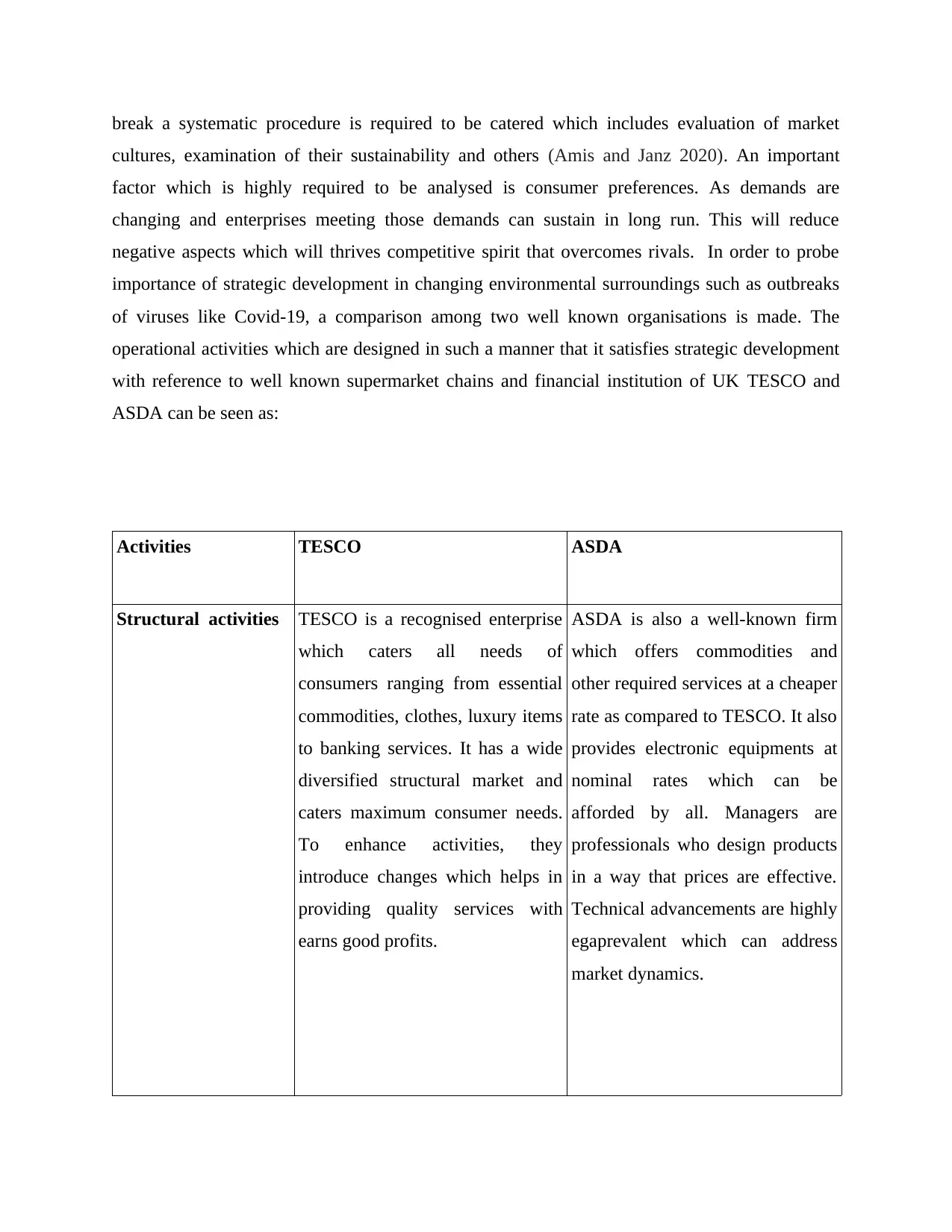
break a systematic procedure is required to be catered which includes evaluation of market
cultures, examination of their sustainability and others (Amis and Janz 2020). An important
factor which is highly required to be analysed is consumer preferences. As demands are
changing and enterprises meeting those demands can sustain in long run. This will reduce
negative aspects which will thrives competitive spirit that overcomes rivals. In order to probe
importance of strategic development in changing environmental surroundings such as outbreaks
of viruses like Covid-19, a comparison among two well known organisations is made. The
operational activities which are designed in such a manner that it satisfies strategic development
with reference to well known supermarket chains and financial institution of UK TESCO and
ASDA can be seen as:
Activities TESCO ASDA
Structural activities TESCO is a recognised enterprise
which caters all needs of
consumers ranging from essential
commodities, clothes, luxury items
to banking services. It has a wide
diversified structural market and
caters maximum consumer needs.
To enhance activities, they
introduce changes which helps in
providing quality services with
earns good profits.
ASDA is also a well-known firm
which offers commodities and
other required services at a cheaper
rate as compared to TESCO. It also
provides electronic equipments at
nominal rates which can be
afforded by all. Managers are
professionals who design products
in a way that prices are effective.
Technical advancements are highly
egaprevalent which can address
market dynamics.
cultures, examination of their sustainability and others (Amis and Janz 2020). An important
factor which is highly required to be analysed is consumer preferences. As demands are
changing and enterprises meeting those demands can sustain in long run. This will reduce
negative aspects which will thrives competitive spirit that overcomes rivals. In order to probe
importance of strategic development in changing environmental surroundings such as outbreaks
of viruses like Covid-19, a comparison among two well known organisations is made. The
operational activities which are designed in such a manner that it satisfies strategic development
with reference to well known supermarket chains and financial institution of UK TESCO and
ASDA can be seen as:
Activities TESCO ASDA
Structural activities TESCO is a recognised enterprise
which caters all needs of
consumers ranging from essential
commodities, clothes, luxury items
to banking services. It has a wide
diversified structural market and
caters maximum consumer needs.
To enhance activities, they
introduce changes which helps in
providing quality services with
earns good profits.
ASDA is also a well-known firm
which offers commodities and
other required services at a cheaper
rate as compared to TESCO. It also
provides electronic equipments at
nominal rates which can be
afforded by all. Managers are
professionals who design products
in a way that prices are effective.
Technical advancements are highly
egaprevalent which can address
market dynamics.
Secure Best Marks with AI Grader
Need help grading? Try our AI Grader for instant feedback on your assignments.
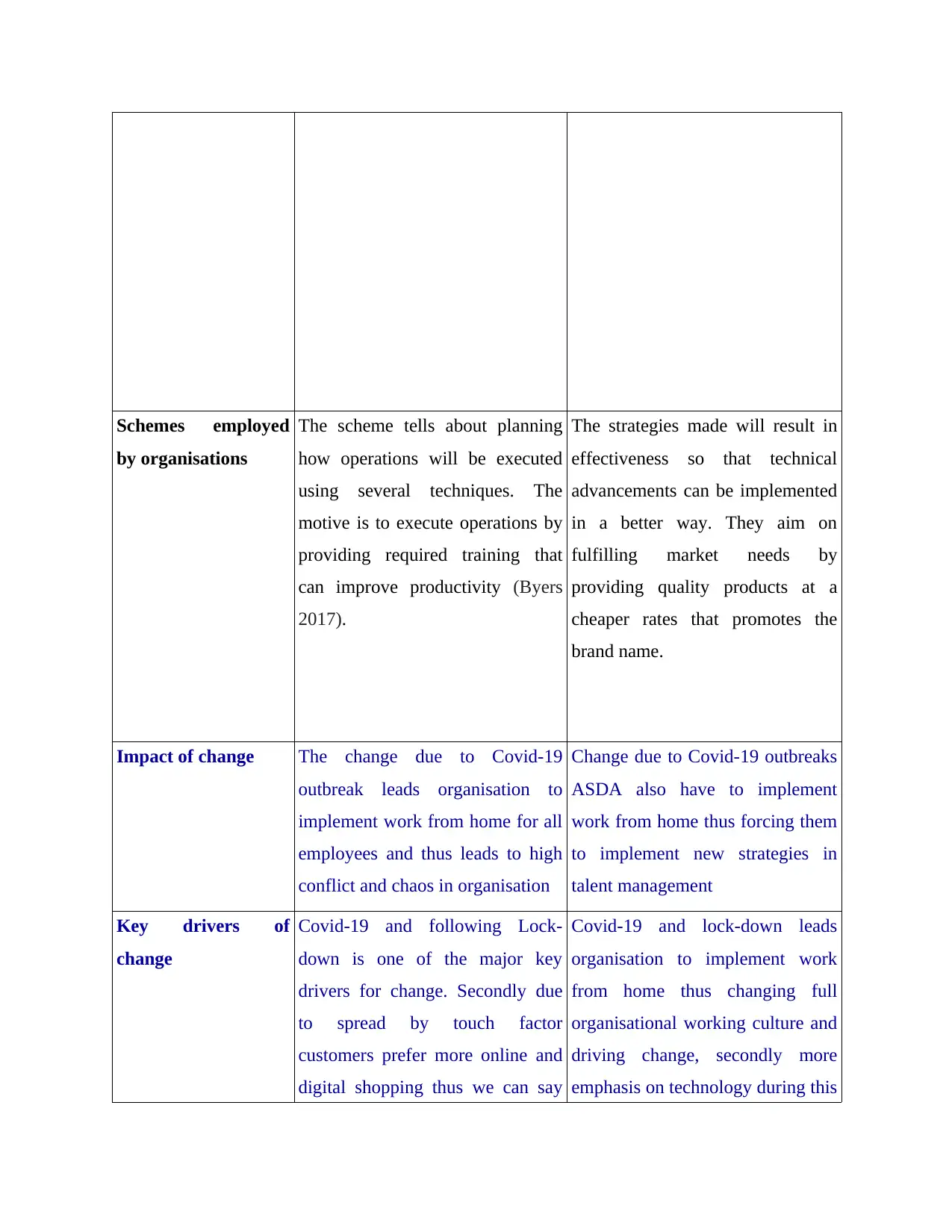
Schemes employed
by organisations
The scheme tells about planning
how operations will be executed
using several techniques. The
motive is to execute operations by
providing required training that
can improve productivity (Byers
2017).
The strategies made will result in
effectiveness so that technical
advancements can be implemented
in a better way. They aim on
fulfilling market needs by
providing quality products at a
cheaper rates that promotes the
brand name.
Impact of change The change due to Covid-19
outbreak leads organisation to
implement work from home for all
employees and thus leads to high
conflict and chaos in organisation
Change due to Covid-19 outbreaks
ASDA also have to implement
work from home thus forcing them
to implement new strategies in
talent management
Key drivers of
change
Covid-19 and following Lock-
down is one of the major key
drivers for change. Secondly due
to spread by touch factor
customers prefer more online and
digital shopping thus we can say
Covid-19 and lock-down leads
organisation to implement work
from home thus changing full
organisational working culture and
driving change, secondly more
emphasis on technology during this
by organisations
The scheme tells about planning
how operations will be executed
using several techniques. The
motive is to execute operations by
providing required training that
can improve productivity (Byers
2017).
The strategies made will result in
effectiveness so that technical
advancements can be implemented
in a better way. They aim on
fulfilling market needs by
providing quality products at a
cheaper rates that promotes the
brand name.
Impact of change The change due to Covid-19
outbreak leads organisation to
implement work from home for all
employees and thus leads to high
conflict and chaos in organisation
Change due to Covid-19 outbreaks
ASDA also have to implement
work from home thus forcing them
to implement new strategies in
talent management
Key drivers of
change
Covid-19 and following Lock-
down is one of the major key
drivers for change. Secondly due
to spread by touch factor
customers prefer more online and
digital shopping thus we can say
Covid-19 and lock-down leads
organisation to implement work
from home thus changing full
organisational working culture and
driving change, secondly more
emphasis on technology during this
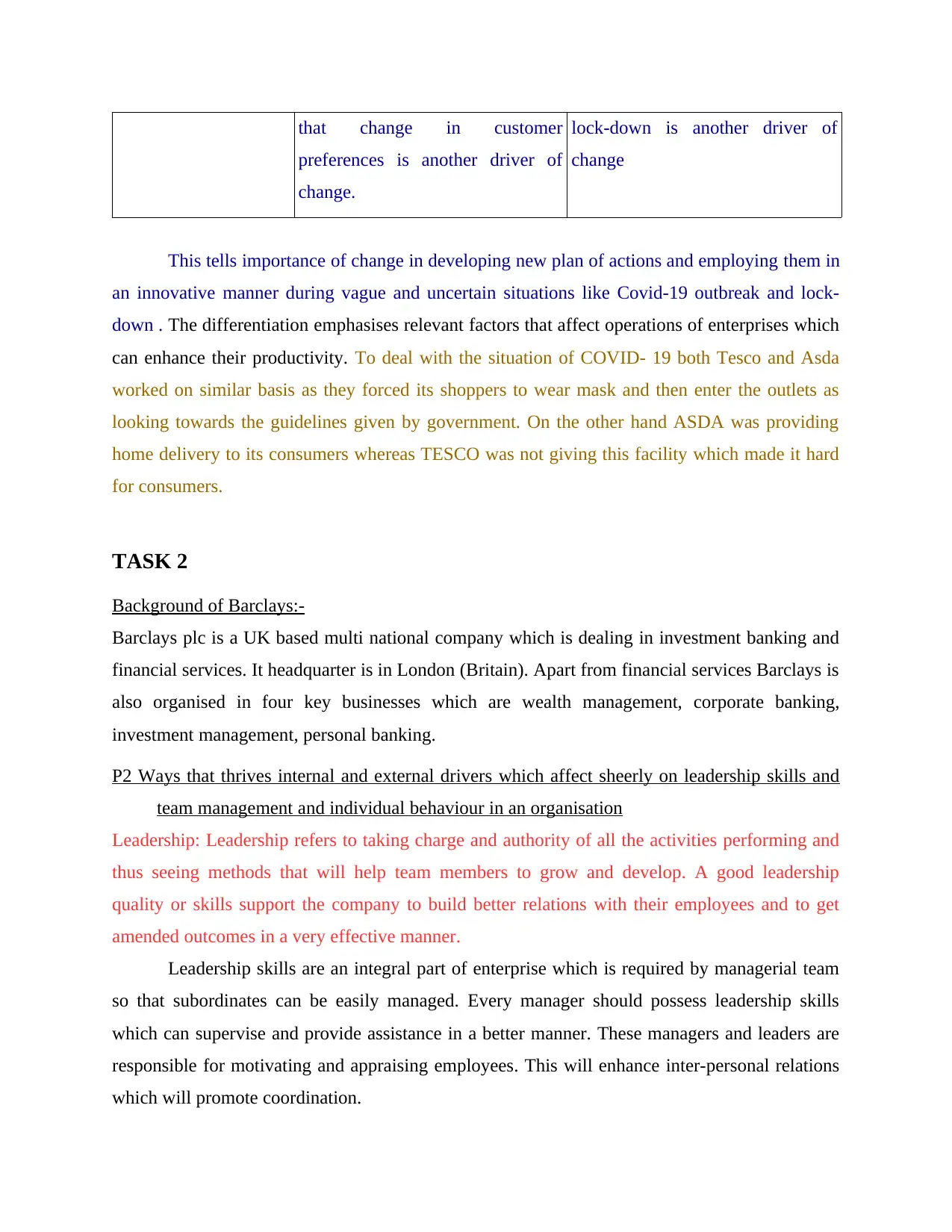
that change in customer
preferences is another driver of
change.
lock-down is another driver of
change
This tells importance of change in developing new plan of actions and employing them in
an innovative manner during vague and uncertain situations like Covid-19 outbreak and lock-
down . The differentiation emphasises relevant factors that affect operations of enterprises which
can enhance their productivity. To deal with the situation of COVID- 19 both Tesco and Asda
worked on similar basis as they forced its shoppers to wear mask and then enter the outlets as
looking towards the guidelines given by government. On the other hand ASDA was providing
home delivery to its consumers whereas TESCO was not giving this facility which made it hard
for consumers.
TASK 2
Background of Barclays:-
Barclays plc is a UK based multi national company which is dealing in investment banking and
financial services. It headquarter is in London (Britain). Apart from financial services Barclays is
also organised in four key businesses which are wealth management, corporate banking,
investment management, personal banking.
P2 Ways that thrives internal and external drivers which affect sheerly on leadership skills and
team management and individual behaviour in an organisation
Leadership: Leadership refers to taking charge and authority of all the activities performing and
thus seeing methods that will help team members to grow and develop. A good leadership
quality or skills support the company to build better relations with their employees and to get
amended outcomes in a very effective manner.
Leadership skills are an integral part of enterprise which is required by managerial team
so that subordinates can be easily managed. Every manager should possess leadership skills
which can supervise and provide assistance in a better manner. These managers and leaders are
responsible for motivating and appraising employees. This will enhance inter-personal relations
which will promote coordination.
preferences is another driver of
change.
lock-down is another driver of
change
This tells importance of change in developing new plan of actions and employing them in
an innovative manner during vague and uncertain situations like Covid-19 outbreak and lock-
down . The differentiation emphasises relevant factors that affect operations of enterprises which
can enhance their productivity. To deal with the situation of COVID- 19 both Tesco and Asda
worked on similar basis as they forced its shoppers to wear mask and then enter the outlets as
looking towards the guidelines given by government. On the other hand ASDA was providing
home delivery to its consumers whereas TESCO was not giving this facility which made it hard
for consumers.
TASK 2
Background of Barclays:-
Barclays plc is a UK based multi national company which is dealing in investment banking and
financial services. It headquarter is in London (Britain). Apart from financial services Barclays is
also organised in four key businesses which are wealth management, corporate banking,
investment management, personal banking.
P2 Ways that thrives internal and external drivers which affect sheerly on leadership skills and
team management and individual behaviour in an organisation
Leadership: Leadership refers to taking charge and authority of all the activities performing and
thus seeing methods that will help team members to grow and develop. A good leadership
quality or skills support the company to build better relations with their employees and to get
amended outcomes in a very effective manner.
Leadership skills are an integral part of enterprise which is required by managerial team
so that subordinates can be easily managed. Every manager should possess leadership skills
which can supervise and provide assistance in a better manner. These managers and leaders are
responsible for motivating and appraising employees. This will enhance inter-personal relations
which will promote coordination.
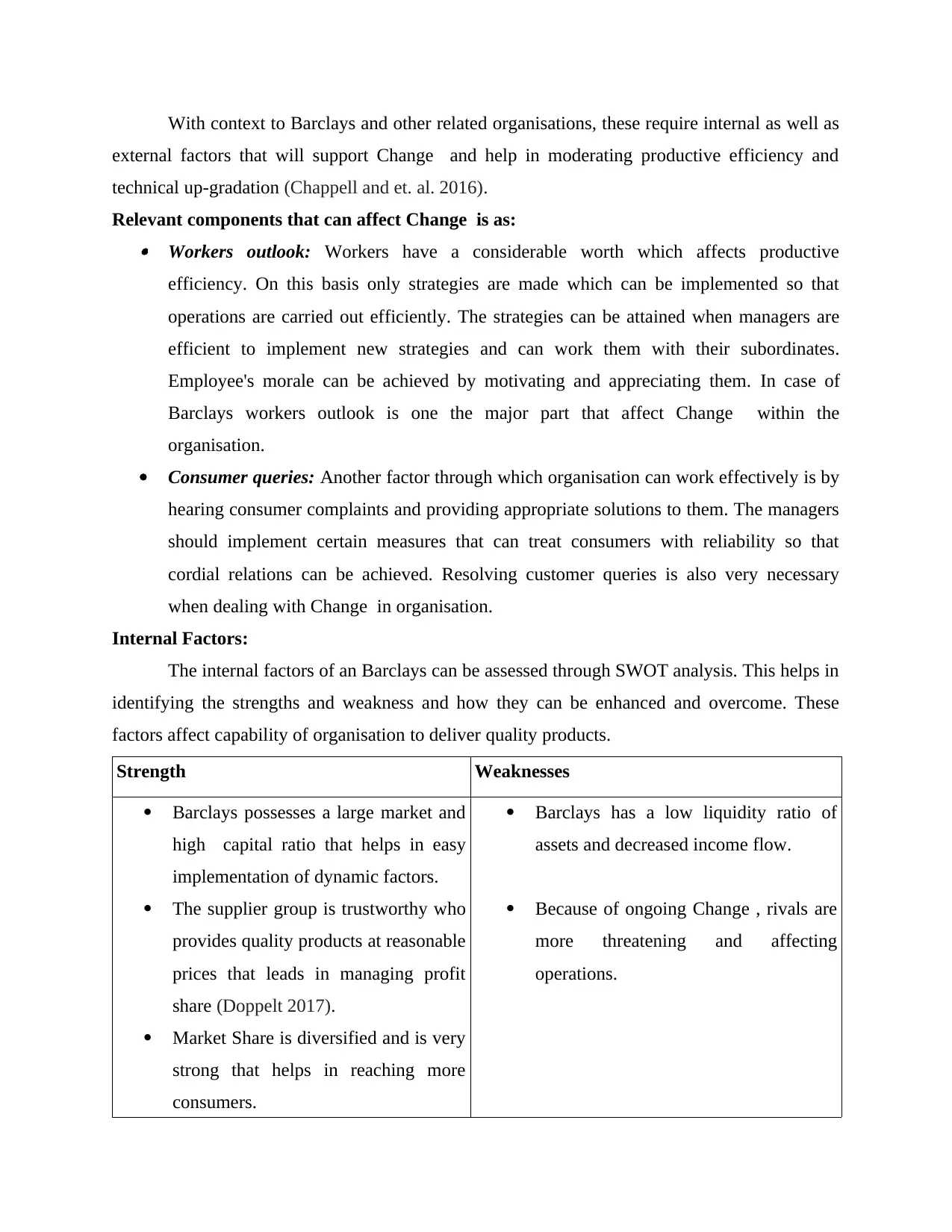
With context to Barclays and other related organisations, these require internal as well as
external factors that will support Change and help in moderating productive efficiency and
technical up-gradation (Chappell and et. al. 2016).
Relevant components that can affect Change is as: Workers outlook: Workers have a considerable worth which affects productive
efficiency. On this basis only strategies are made which can be implemented so that
operations are carried out efficiently. The strategies can be attained when managers are
efficient to implement new strategies and can work them with their subordinates.
Employee's morale can be achieved by motivating and appreciating them. In case of
Barclays workers outlook is one the major part that affect Change within the
organisation.
Consumer queries: Another factor through which organisation can work effectively is by
hearing consumer complaints and providing appropriate solutions to them. The managers
should implement certain measures that can treat consumers with reliability so that
cordial relations can be achieved. Resolving customer queries is also very necessary
when dealing with Change in organisation.
Internal Factors:
The internal factors of an Barclays can be assessed through SWOT analysis. This helps in
identifying the strengths and weakness and how they can be enhanced and overcome. These
factors affect capability of organisation to deliver quality products.
Strength Weaknesses
Barclays possesses a large market and
high capital ratio that helps in easy
implementation of dynamic factors.
The supplier group is trustworthy who
provides quality products at reasonable
prices that leads in managing profit
share (Doppelt 2017).
Market Share is diversified and is very
strong that helps in reaching more
consumers.
Barclays has a low liquidity ratio of
assets and decreased income flow.
Because of ongoing Change , rivals are
more threatening and affecting
operations.
external factors that will support Change and help in moderating productive efficiency and
technical up-gradation (Chappell and et. al. 2016).
Relevant components that can affect Change is as: Workers outlook: Workers have a considerable worth which affects productive
efficiency. On this basis only strategies are made which can be implemented so that
operations are carried out efficiently. The strategies can be attained when managers are
efficient to implement new strategies and can work them with their subordinates.
Employee's morale can be achieved by motivating and appreciating them. In case of
Barclays workers outlook is one the major part that affect Change within the
organisation.
Consumer queries: Another factor through which organisation can work effectively is by
hearing consumer complaints and providing appropriate solutions to them. The managers
should implement certain measures that can treat consumers with reliability so that
cordial relations can be achieved. Resolving customer queries is also very necessary
when dealing with Change in organisation.
Internal Factors:
The internal factors of an Barclays can be assessed through SWOT analysis. This helps in
identifying the strengths and weakness and how they can be enhanced and overcome. These
factors affect capability of organisation to deliver quality products.
Strength Weaknesses
Barclays possesses a large market and
high capital ratio that helps in easy
implementation of dynamic factors.
The supplier group is trustworthy who
provides quality products at reasonable
prices that leads in managing profit
share (Doppelt 2017).
Market Share is diversified and is very
strong that helps in reaching more
consumers.
Barclays has a low liquidity ratio of
assets and decreased income flow.
Because of ongoing Change , rivals are
more threatening and affecting
operations.
Paraphrase This Document
Need a fresh take? Get an instant paraphrase of this document with our AI Paraphraser
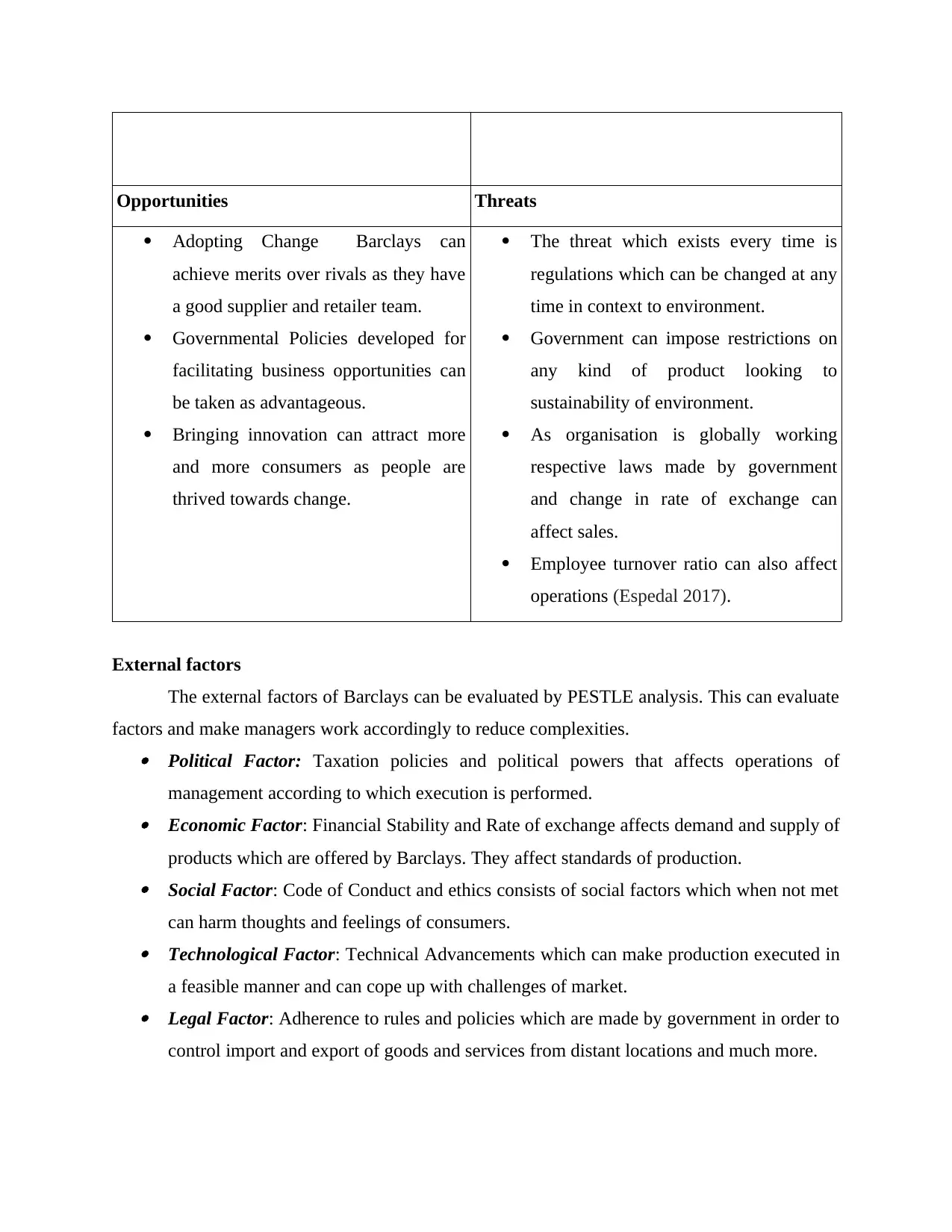
Opportunities Threats
Adopting Change Barclays can
achieve merits over rivals as they have
a good supplier and retailer team.
Governmental Policies developed for
facilitating business opportunities can
be taken as advantageous.
Bringing innovation can attract more
and more consumers as people are
thrived towards change.
The threat which exists every time is
regulations which can be changed at any
time in context to environment.
Government can impose restrictions on
any kind of product looking to
sustainability of environment.
As organisation is globally working
respective laws made by government
and change in rate of exchange can
affect sales.
Employee turnover ratio can also affect
operations (Espedal 2017).
External factors
The external factors of Barclays can be evaluated by PESTLE analysis. This can evaluate
factors and make managers work accordingly to reduce complexities. Political Factor: Taxation policies and political powers that affects operations of
management according to which execution is performed. Economic Factor: Financial Stability and Rate of exchange affects demand and supply of
products which are offered by Barclays. They affect standards of production. Social Factor: Code of Conduct and ethics consists of social factors which when not met
can harm thoughts and feelings of consumers. Technological Factor: Technical Advancements which can make production executed in
a feasible manner and can cope up with challenges of market. Legal Factor: Adherence to rules and policies which are made by government in order to
control import and export of goods and services from distant locations and much more.
Adopting Change Barclays can
achieve merits over rivals as they have
a good supplier and retailer team.
Governmental Policies developed for
facilitating business opportunities can
be taken as advantageous.
Bringing innovation can attract more
and more consumers as people are
thrived towards change.
The threat which exists every time is
regulations which can be changed at any
time in context to environment.
Government can impose restrictions on
any kind of product looking to
sustainability of environment.
As organisation is globally working
respective laws made by government
and change in rate of exchange can
affect sales.
Employee turnover ratio can also affect
operations (Espedal 2017).
External factors
The external factors of Barclays can be evaluated by PESTLE analysis. This can evaluate
factors and make managers work accordingly to reduce complexities. Political Factor: Taxation policies and political powers that affects operations of
management according to which execution is performed. Economic Factor: Financial Stability and Rate of exchange affects demand and supply of
products which are offered by Barclays. They affect standards of production. Social Factor: Code of Conduct and ethics consists of social factors which when not met
can harm thoughts and feelings of consumers. Technological Factor: Technical Advancements which can make production executed in
a feasible manner and can cope up with challenges of market. Legal Factor: Adherence to rules and policies which are made by government in order to
control import and export of goods and services from distant locations and much more.
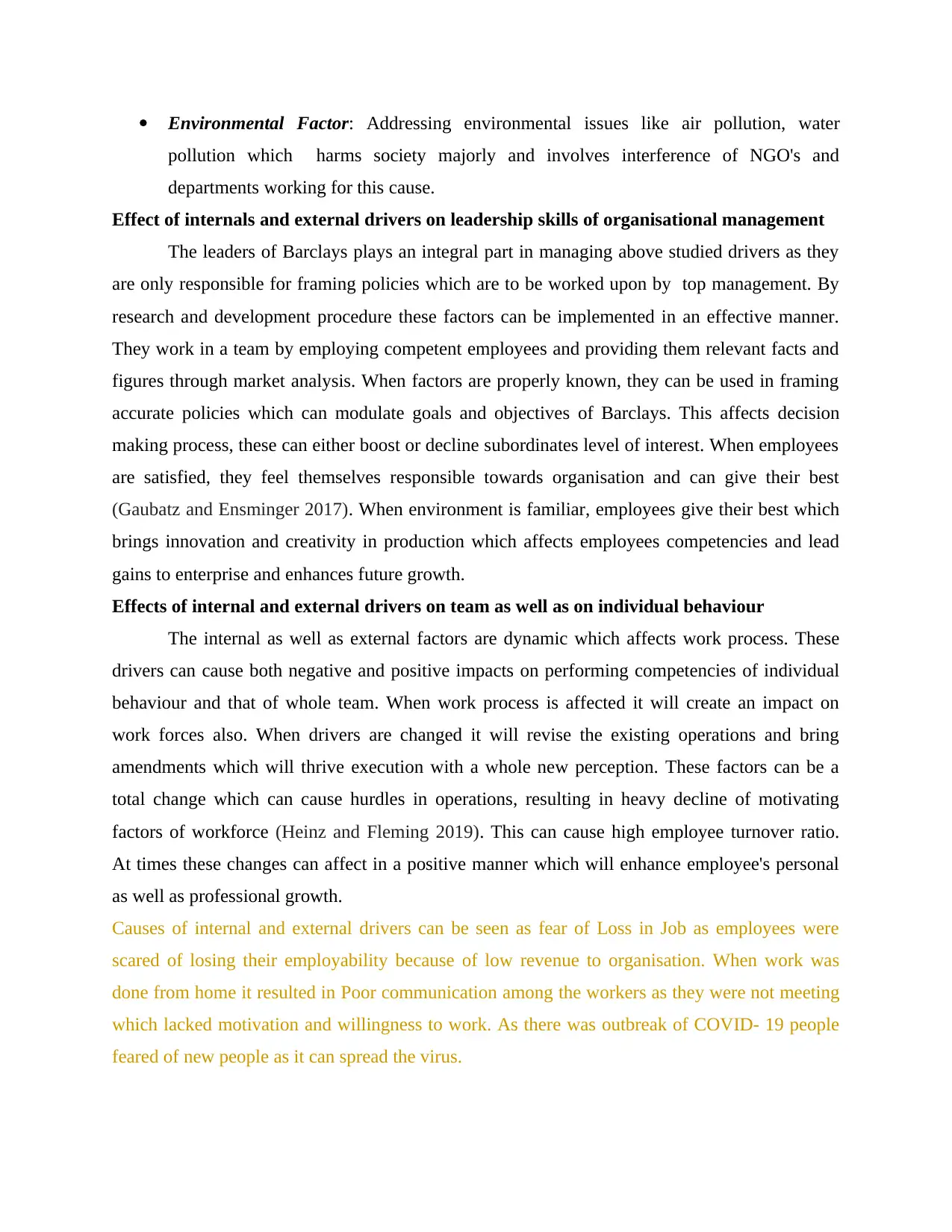
Environmental Factor: Addressing environmental issues like air pollution, water
pollution which harms society majorly and involves interference of NGO's and
departments working for this cause.
Effect of internals and external drivers on leadership skills of organisational management
The leaders of Barclays plays an integral part in managing above studied drivers as they
are only responsible for framing policies which are to be worked upon by top management. By
research and development procedure these factors can be implemented in an effective manner.
They work in a team by employing competent employees and providing them relevant facts and
figures through market analysis. When factors are properly known, they can be used in framing
accurate policies which can modulate goals and objectives of Barclays. This affects decision
making process, these can either boost or decline subordinates level of interest. When employees
are satisfied, they feel themselves responsible towards organisation and can give their best
(Gaubatz and Ensminger 2017). When environment is familiar, employees give their best which
brings innovation and creativity in production which affects employees competencies and lead
gains to enterprise and enhances future growth.
Effects of internal and external drivers on team as well as on individual behaviour
The internal as well as external factors are dynamic which affects work process. These
drivers can cause both negative and positive impacts on performing competencies of individual
behaviour and that of whole team. When work process is affected it will create an impact on
work forces also. When drivers are changed it will revise the existing operations and bring
amendments which will thrive execution with a whole new perception. These factors can be a
total change which can cause hurdles in operations, resulting in heavy decline of motivating
factors of workforce (Heinz and Fleming 2019). This can cause high employee turnover ratio.
At times these changes can affect in a positive manner which will enhance employee's personal
as well as professional growth.
Causes of internal and external drivers can be seen as fear of Loss in Job as employees were
scared of losing their employability because of low revenue to organisation. When work was
done from home it resulted in Poor communication among the workers as they were not meeting
which lacked motivation and willingness to work. As there was outbreak of COVID- 19 people
feared of new people as it can spread the virus.
pollution which harms society majorly and involves interference of NGO's and
departments working for this cause.
Effect of internals and external drivers on leadership skills of organisational management
The leaders of Barclays plays an integral part in managing above studied drivers as they
are only responsible for framing policies which are to be worked upon by top management. By
research and development procedure these factors can be implemented in an effective manner.
They work in a team by employing competent employees and providing them relevant facts and
figures through market analysis. When factors are properly known, they can be used in framing
accurate policies which can modulate goals and objectives of Barclays. This affects decision
making process, these can either boost or decline subordinates level of interest. When employees
are satisfied, they feel themselves responsible towards organisation and can give their best
(Gaubatz and Ensminger 2017). When environment is familiar, employees give their best which
brings innovation and creativity in production which affects employees competencies and lead
gains to enterprise and enhances future growth.
Effects of internal and external drivers on team as well as on individual behaviour
The internal as well as external factors are dynamic which affects work process. These
drivers can cause both negative and positive impacts on performing competencies of individual
behaviour and that of whole team. When work process is affected it will create an impact on
work forces also. When drivers are changed it will revise the existing operations and bring
amendments which will thrive execution with a whole new perception. These factors can be a
total change which can cause hurdles in operations, resulting in heavy decline of motivating
factors of workforce (Heinz and Fleming 2019). This can cause high employee turnover ratio.
At times these changes can affect in a positive manner which will enhance employee's personal
as well as professional growth.
Causes of internal and external drivers can be seen as fear of Loss in Job as employees were
scared of losing their employability because of low revenue to organisation. When work was
done from home it resulted in Poor communication among the workers as they were not meeting
which lacked motivation and willingness to work. As there was outbreak of COVID- 19 people
feared of new people as it can spread the virus.
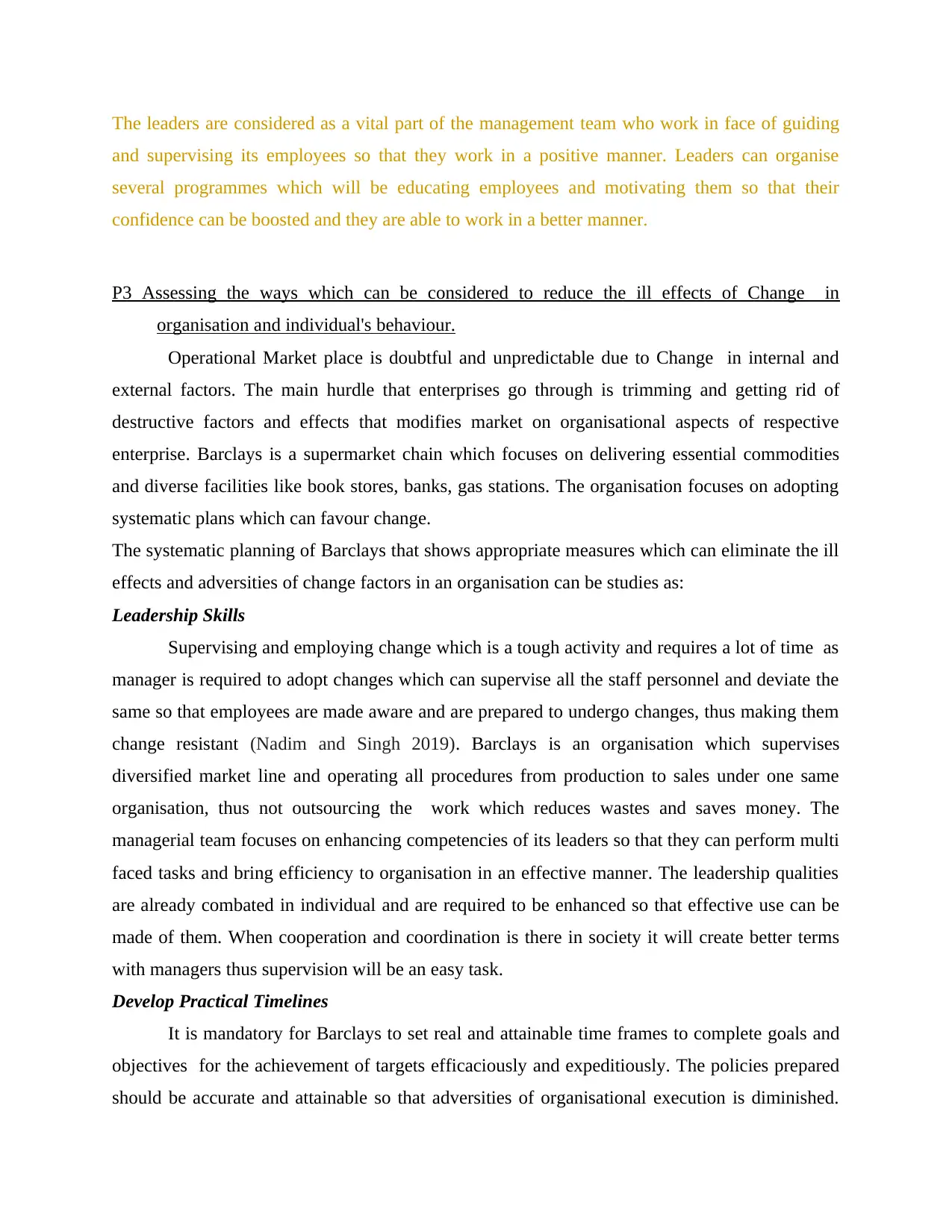
The leaders are considered as a vital part of the management team who work in face of guiding
and supervising its employees so that they work in a positive manner. Leaders can organise
several programmes which will be educating employees and motivating them so that their
confidence can be boosted and they are able to work in a better manner.
P3 Assessing the ways which can be considered to reduce the ill effects of Change in
organisation and individual's behaviour.
Operational Market place is doubtful and unpredictable due to Change in internal and
external factors. The main hurdle that enterprises go through is trimming and getting rid of
destructive factors and effects that modifies market on organisational aspects of respective
enterprise. Barclays is a supermarket chain which focuses on delivering essential commodities
and diverse facilities like book stores, banks, gas stations. The organisation focuses on adopting
systematic plans which can favour change.
The systematic planning of Barclays that shows appropriate measures which can eliminate the ill
effects and adversities of change factors in an organisation can be studies as:
Leadership Skills
Supervising and employing change which is a tough activity and requires a lot of time as
manager is required to adopt changes which can supervise all the staff personnel and deviate the
same so that employees are made aware and are prepared to undergo changes, thus making them
change resistant (Nadim and Singh 2019). Barclays is an organisation which supervises
diversified market line and operating all procedures from production to sales under one same
organisation, thus not outsourcing the work which reduces wastes and saves money. The
managerial team focuses on enhancing competencies of its leaders so that they can perform multi
faced tasks and bring efficiency to organisation in an effective manner. The leadership qualities
are already combated in individual and are required to be enhanced so that effective use can be
made of them. When cooperation and coordination is there in society it will create better terms
with managers thus supervision will be an easy task.
Develop Practical Timelines
It is mandatory for Barclays to set real and attainable time frames to complete goals and
objectives for the achievement of targets efficaciously and expeditiously. The policies prepared
should be accurate and attainable so that adversities of organisational execution is diminished.
and supervising its employees so that they work in a positive manner. Leaders can organise
several programmes which will be educating employees and motivating them so that their
confidence can be boosted and they are able to work in a better manner.
P3 Assessing the ways which can be considered to reduce the ill effects of Change in
organisation and individual's behaviour.
Operational Market place is doubtful and unpredictable due to Change in internal and
external factors. The main hurdle that enterprises go through is trimming and getting rid of
destructive factors and effects that modifies market on organisational aspects of respective
enterprise. Barclays is a supermarket chain which focuses on delivering essential commodities
and diverse facilities like book stores, banks, gas stations. The organisation focuses on adopting
systematic plans which can favour change.
The systematic planning of Barclays that shows appropriate measures which can eliminate the ill
effects and adversities of change factors in an organisation can be studies as:
Leadership Skills
Supervising and employing change which is a tough activity and requires a lot of time as
manager is required to adopt changes which can supervise all the staff personnel and deviate the
same so that employees are made aware and are prepared to undergo changes, thus making them
change resistant (Nadim and Singh 2019). Barclays is an organisation which supervises
diversified market line and operating all procedures from production to sales under one same
organisation, thus not outsourcing the work which reduces wastes and saves money. The
managerial team focuses on enhancing competencies of its leaders so that they can perform multi
faced tasks and bring efficiency to organisation in an effective manner. The leadership qualities
are already combated in individual and are required to be enhanced so that effective use can be
made of them. When cooperation and coordination is there in society it will create better terms
with managers thus supervision will be an easy task.
Develop Practical Timelines
It is mandatory for Barclays to set real and attainable time frames to complete goals and
objectives for the achievement of targets efficaciously and expeditiously. The policies prepared
should be accurate and attainable so that adversities of organisational execution is diminished.
Secure Best Marks with AI Grader
Need help grading? Try our AI Grader for instant feedback on your assignments.
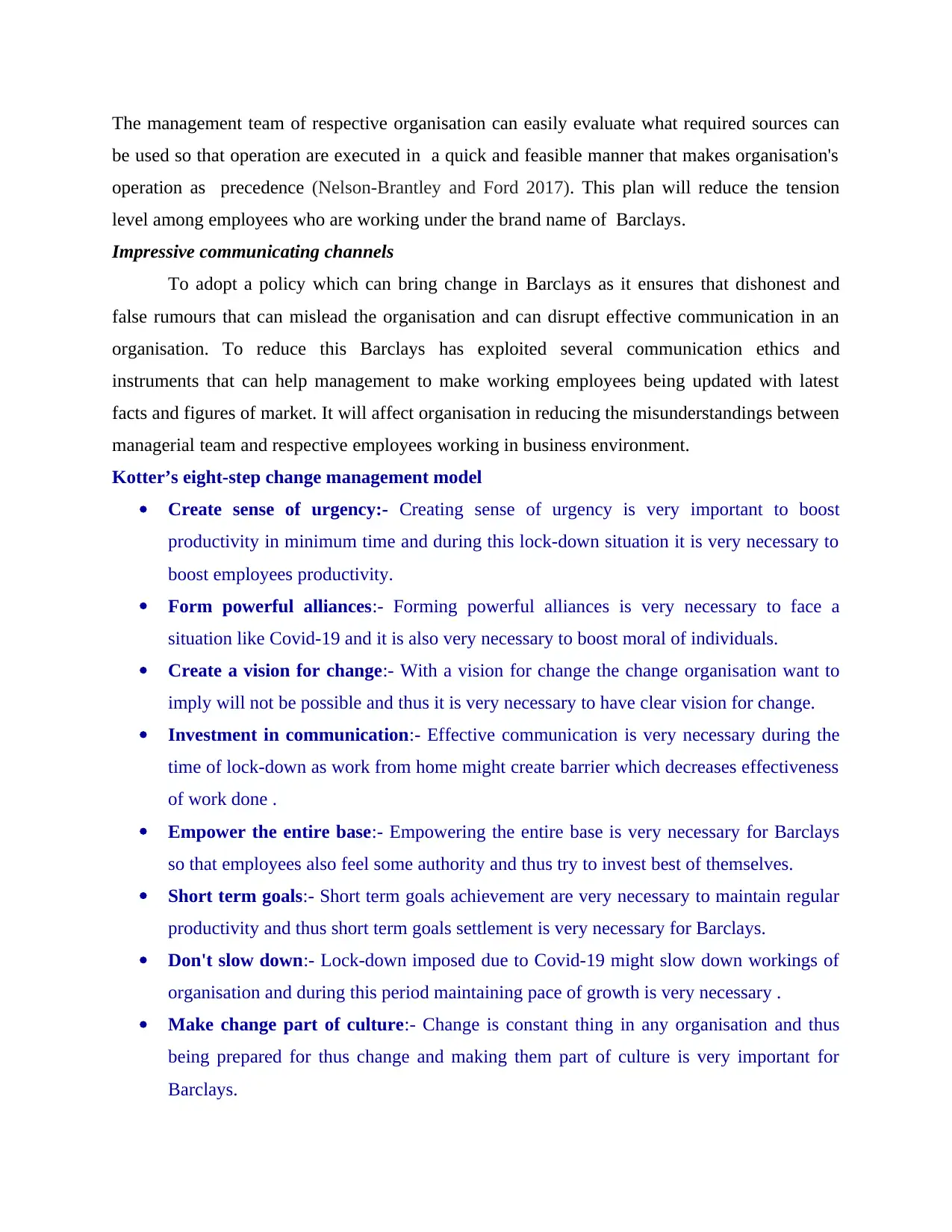
The management team of respective organisation can easily evaluate what required sources can
be used so that operation are executed in a quick and feasible manner that makes organisation's
operation as precedence (Nelson‐Brantley and Ford 2017). This plan will reduce the tension
level among employees who are working under the brand name of Barclays.
Impressive communicating channels
To adopt a policy which can bring change in Barclays as it ensures that dishonest and
false rumours that can mislead the organisation and can disrupt effective communication in an
organisation. To reduce this Barclays has exploited several communication ethics and
instruments that can help management to make working employees being updated with latest
facts and figures of market. It will affect organisation in reducing the misunderstandings between
managerial team and respective employees working in business environment.
Kotter’s eight-step change management model
Create sense of urgency:- Creating sense of urgency is very important to boost
productivity in minimum time and during this lock-down situation it is very necessary to
boost employees productivity.
Form powerful alliances:- Forming powerful alliances is very necessary to face a
situation like Covid-19 and it is also very necessary to boost moral of individuals.
Create a vision for change:- With a vision for change the change organisation want to
imply will not be possible and thus it is very necessary to have clear vision for change.
Investment in communication:- Effective communication is very necessary during the
time of lock-down as work from home might create barrier which decreases effectiveness
of work done .
Empower the entire base:- Empowering the entire base is very necessary for Barclays
so that employees also feel some authority and thus try to invest best of themselves.
Short term goals:- Short term goals achievement are very necessary to maintain regular
productivity and thus short term goals settlement is very necessary for Barclays.
Don't slow down:- Lock-down imposed due to Covid-19 might slow down workings of
organisation and during this period maintaining pace of growth is very necessary .
Make change part of culture:- Change is constant thing in any organisation and thus
being prepared for thus change and making them part of culture is very important for
Barclays.
be used so that operation are executed in a quick and feasible manner that makes organisation's
operation as precedence (Nelson‐Brantley and Ford 2017). This plan will reduce the tension
level among employees who are working under the brand name of Barclays.
Impressive communicating channels
To adopt a policy which can bring change in Barclays as it ensures that dishonest and
false rumours that can mislead the organisation and can disrupt effective communication in an
organisation. To reduce this Barclays has exploited several communication ethics and
instruments that can help management to make working employees being updated with latest
facts and figures of market. It will affect organisation in reducing the misunderstandings between
managerial team and respective employees working in business environment.
Kotter’s eight-step change management model
Create sense of urgency:- Creating sense of urgency is very important to boost
productivity in minimum time and during this lock-down situation it is very necessary to
boost employees productivity.
Form powerful alliances:- Forming powerful alliances is very necessary to face a
situation like Covid-19 and it is also very necessary to boost moral of individuals.
Create a vision for change:- With a vision for change the change organisation want to
imply will not be possible and thus it is very necessary to have clear vision for change.
Investment in communication:- Effective communication is very necessary during the
time of lock-down as work from home might create barrier which decreases effectiveness
of work done .
Empower the entire base:- Empowering the entire base is very necessary for Barclays
so that employees also feel some authority and thus try to invest best of themselves.
Short term goals:- Short term goals achievement are very necessary to maintain regular
productivity and thus short term goals settlement is very necessary for Barclays.
Don't slow down:- Lock-down imposed due to Covid-19 might slow down workings of
organisation and during this period maintaining pace of growth is very necessary .
Make change part of culture:- Change is constant thing in any organisation and thus
being prepared for thus change and making them part of culture is very important for
Barclays.
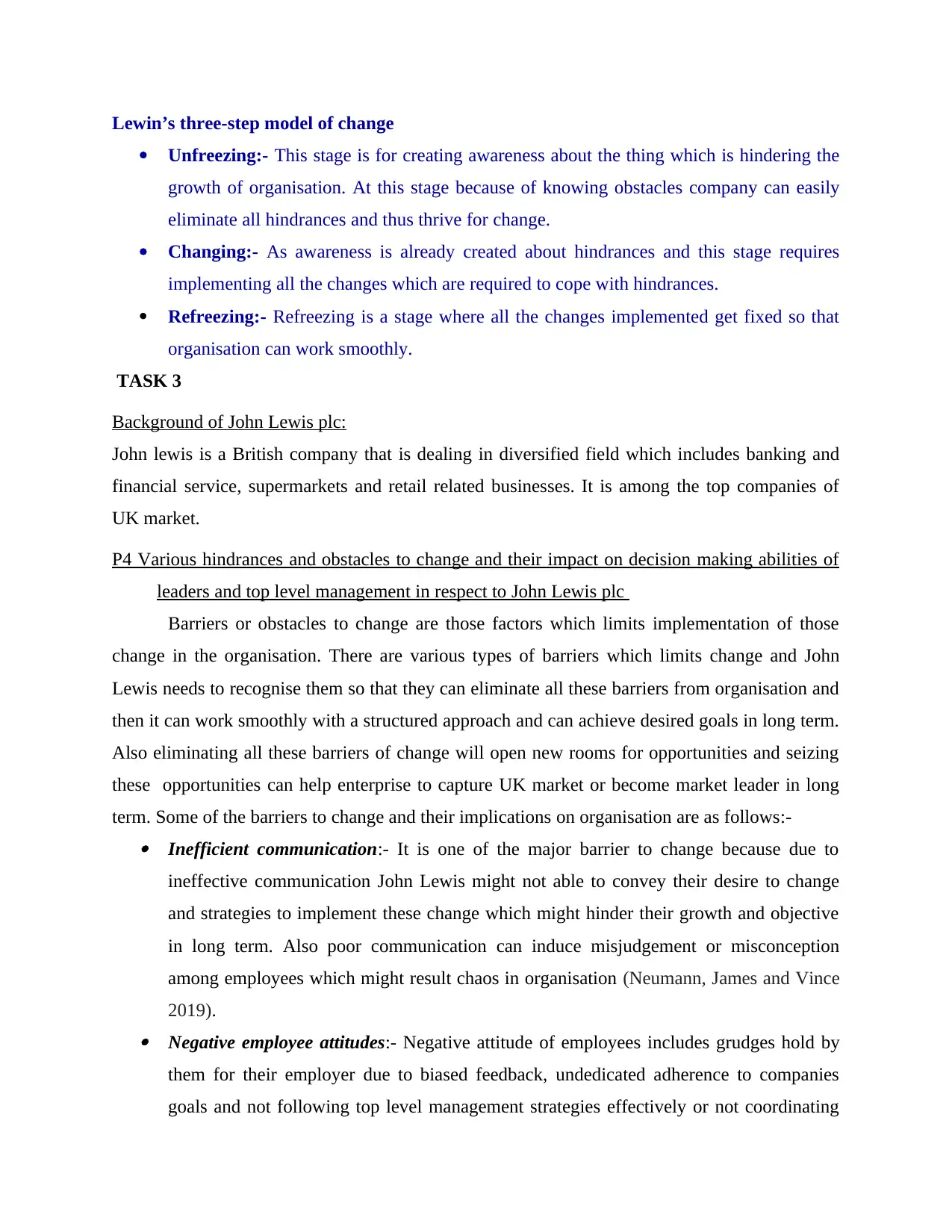
Lewin’s three-step model of change
Unfreezing:- This stage is for creating awareness about the thing which is hindering the
growth of organisation. At this stage because of knowing obstacles company can easily
eliminate all hindrances and thus thrive for change.
Changing:- As awareness is already created about hindrances and this stage requires
implementing all the changes which are required to cope with hindrances.
Refreezing:- Refreezing is a stage where all the changes implemented get fixed so that
organisation can work smoothly.
TASK 3
Background of John Lewis plc:
John lewis is a British company that is dealing in diversified field which includes banking and
financial service, supermarkets and retail related businesses. It is among the top companies of
UK market.
P4 Various hindrances and obstacles to change and their impact on decision making abilities of
leaders and top level management in respect to John Lewis plc
Barriers or obstacles to change are those factors which limits implementation of those
change in the organisation. There are various types of barriers which limits change and John
Lewis needs to recognise them so that they can eliminate all these barriers from organisation and
then it can work smoothly with a structured approach and can achieve desired goals in long term.
Also eliminating all these barriers of change will open new rooms for opportunities and seizing
these opportunities can help enterprise to capture UK market or become market leader in long
term. Some of the barriers to change and their implications on organisation are as follows:- Inefficient communication:- It is one of the major barrier to change because due to
ineffective communication John Lewis might not able to convey their desire to change
and strategies to implement these change which might hinder their growth and objective
in long term. Also poor communication can induce misjudgement or misconception
among employees which might result chaos in organisation (Neumann, James and Vince
2019). Negative employee attitudes:- Negative attitude of employees includes grudges hold by
them for their employer due to biased feedback, undedicated adherence to companies
goals and not following top level management strategies effectively or not coordinating
Unfreezing:- This stage is for creating awareness about the thing which is hindering the
growth of organisation. At this stage because of knowing obstacles company can easily
eliminate all hindrances and thus thrive for change.
Changing:- As awareness is already created about hindrances and this stage requires
implementing all the changes which are required to cope with hindrances.
Refreezing:- Refreezing is a stage where all the changes implemented get fixed so that
organisation can work smoothly.
TASK 3
Background of John Lewis plc:
John lewis is a British company that is dealing in diversified field which includes banking and
financial service, supermarkets and retail related businesses. It is among the top companies of
UK market.
P4 Various hindrances and obstacles to change and their impact on decision making abilities of
leaders and top level management in respect to John Lewis plc
Barriers or obstacles to change are those factors which limits implementation of those
change in the organisation. There are various types of barriers which limits change and John
Lewis needs to recognise them so that they can eliminate all these barriers from organisation and
then it can work smoothly with a structured approach and can achieve desired goals in long term.
Also eliminating all these barriers of change will open new rooms for opportunities and seizing
these opportunities can help enterprise to capture UK market or become market leader in long
term. Some of the barriers to change and their implications on organisation are as follows:- Inefficient communication:- It is one of the major barrier to change because due to
ineffective communication John Lewis might not able to convey their desire to change
and strategies to implement these change which might hinder their growth and objective
in long term. Also poor communication can induce misjudgement or misconception
among employees which might result chaos in organisation (Neumann, James and Vince
2019). Negative employee attitudes:- Negative attitude of employees includes grudges hold by
them for their employer due to biased feedback, undedicated adherence to companies
goals and not following top level management strategies effectively or not coordinating
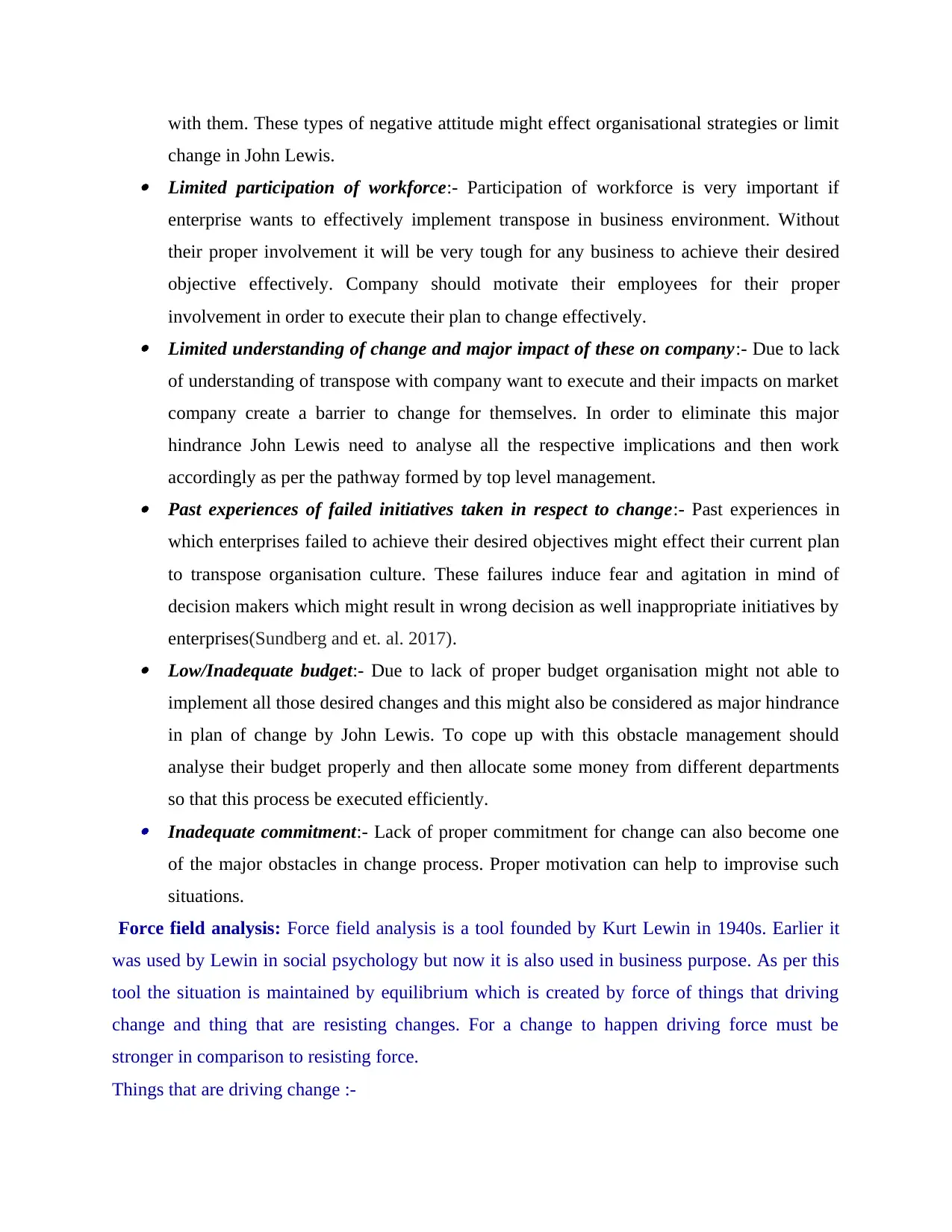
with them. These types of negative attitude might effect organisational strategies or limit
change in John Lewis. Limited participation of workforce:- Participation of workforce is very important if
enterprise wants to effectively implement transpose in business environment. Without
their proper involvement it will be very tough for any business to achieve their desired
objective effectively. Company should motivate their employees for their proper
involvement in order to execute their plan to change effectively. Limited understanding of change and major impact of these on company:- Due to lack
of understanding of transpose with company want to execute and their impacts on market
company create a barrier to change for themselves. In order to eliminate this major
hindrance John Lewis need to analyse all the respective implications and then work
accordingly as per the pathway formed by top level management. Past experiences of failed initiatives taken in respect to change:- Past experiences in
which enterprises failed to achieve their desired objectives might effect their current plan
to transpose organisation culture. These failures induce fear and agitation in mind of
decision makers which might result in wrong decision as well inappropriate initiatives by
enterprises(Sundberg and et. al. 2017). Low/Inadequate budget:- Due to lack of proper budget organisation might not able to
implement all those desired changes and this might also be considered as major hindrance
in plan of change by John Lewis. To cope up with this obstacle management should
analyse their budget properly and then allocate some money from different departments
so that this process be executed efficiently. Inadequate commitment:- Lack of proper commitment for change can also become one
of the major obstacles in change process. Proper motivation can help to improvise such
situations.
Force field analysis: Force field analysis is a tool founded by Kurt Lewin in 1940s. Earlier it
was used by Lewin in social psychology but now it is also used in business purpose. As per this
tool the situation is maintained by equilibrium which is created by force of things that driving
change and thing that are resisting changes. For a change to happen driving force must be
stronger in comparison to resisting force.
Things that are driving change :-
change in John Lewis. Limited participation of workforce:- Participation of workforce is very important if
enterprise wants to effectively implement transpose in business environment. Without
their proper involvement it will be very tough for any business to achieve their desired
objective effectively. Company should motivate their employees for their proper
involvement in order to execute their plan to change effectively. Limited understanding of change and major impact of these on company:- Due to lack
of understanding of transpose with company want to execute and their impacts on market
company create a barrier to change for themselves. In order to eliminate this major
hindrance John Lewis need to analyse all the respective implications and then work
accordingly as per the pathway formed by top level management. Past experiences of failed initiatives taken in respect to change:- Past experiences in
which enterprises failed to achieve their desired objectives might effect their current plan
to transpose organisation culture. These failures induce fear and agitation in mind of
decision makers which might result in wrong decision as well inappropriate initiatives by
enterprises(Sundberg and et. al. 2017). Low/Inadequate budget:- Due to lack of proper budget organisation might not able to
implement all those desired changes and this might also be considered as major hindrance
in plan of change by John Lewis. To cope up with this obstacle management should
analyse their budget properly and then allocate some money from different departments
so that this process be executed efficiently. Inadequate commitment:- Lack of proper commitment for change can also become one
of the major obstacles in change process. Proper motivation can help to improvise such
situations.
Force field analysis: Force field analysis is a tool founded by Kurt Lewin in 1940s. Earlier it
was used by Lewin in social psychology but now it is also used in business purpose. As per this
tool the situation is maintained by equilibrium which is created by force of things that driving
change and thing that are resisting changes. For a change to happen driving force must be
stronger in comparison to resisting force.
Things that are driving change :-
Paraphrase This Document
Need a fresh take? Get an instant paraphrase of this document with our AI Paraphraser
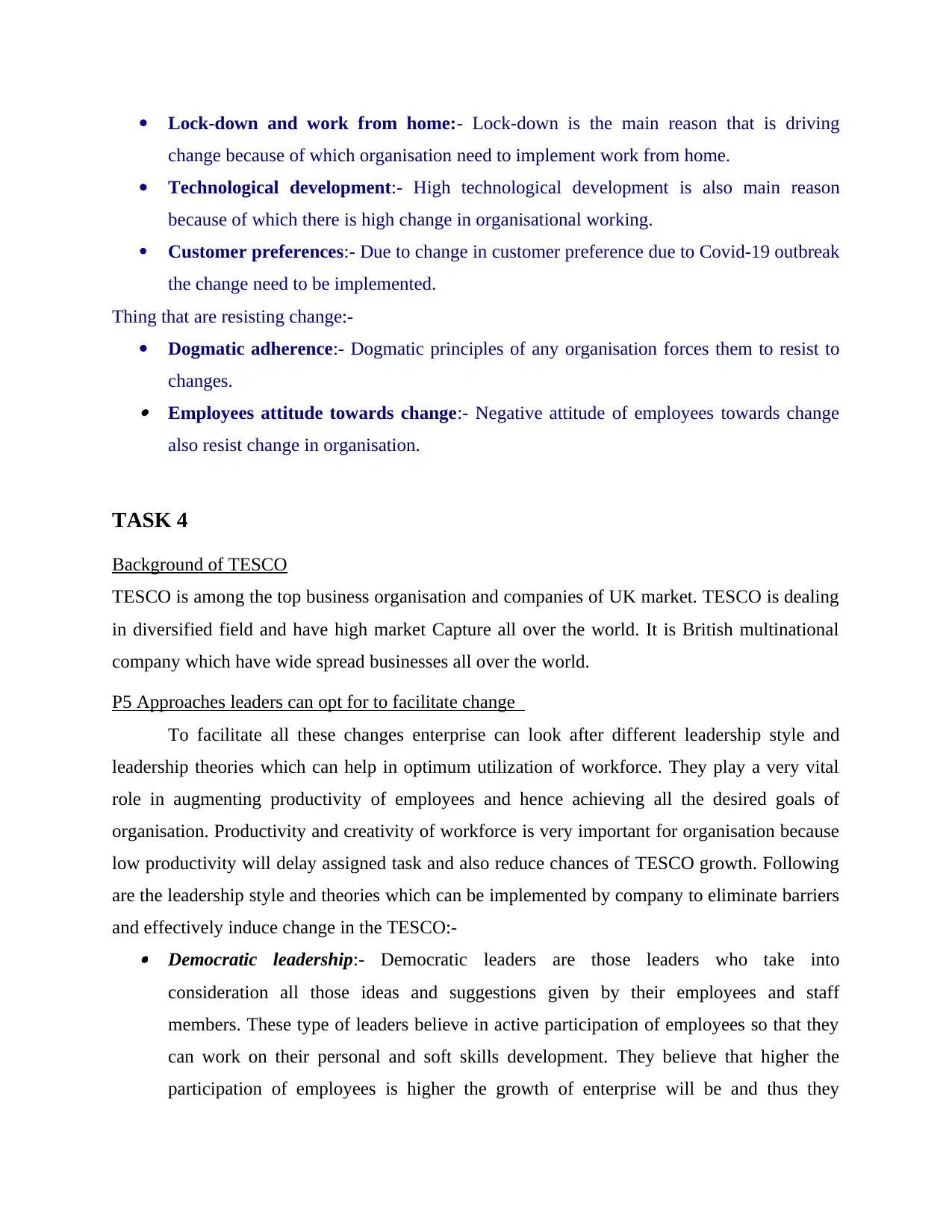
Lock-down and work from home:- Lock-down is the main reason that is driving
change because of which organisation need to implement work from home.
Technological development:- High technological development is also main reason
because of which there is high change in organisational working.
Customer preferences:- Due to change in customer preference due to Covid-19 outbreak
the change need to be implemented.
Thing that are resisting change:-
Dogmatic adherence:- Dogmatic principles of any organisation forces them to resist to
changes. Employees attitude towards change:- Negative attitude of employees towards change
also resist change in organisation.
TASK 4
Background of TESCO
TESCO is among the top business organisation and companies of UK market. TESCO is dealing
in diversified field and have high market Capture all over the world. It is British multinational
company which have wide spread businesses all over the world.
P5 Approaches leaders can opt for to facilitate change
To facilitate all these changes enterprise can look after different leadership style and
leadership theories which can help in optimum utilization of workforce. They play a very vital
role in augmenting productivity of employees and hence achieving all the desired goals of
organisation. Productivity and creativity of workforce is very important for organisation because
low productivity will delay assigned task and also reduce chances of TESCO growth. Following
are the leadership style and theories which can be implemented by company to eliminate barriers
and effectively induce change in the TESCO:- Democratic leadership:- Democratic leaders are those leaders who take into
consideration all those ideas and suggestions given by their employees and staff
members. These type of leaders believe in active participation of employees so that they
can work on their personal and soft skills development. They believe that higher the
participation of employees is higher the growth of enterprise will be and thus they
change because of which organisation need to implement work from home.
Technological development:- High technological development is also main reason
because of which there is high change in organisational working.
Customer preferences:- Due to change in customer preference due to Covid-19 outbreak
the change need to be implemented.
Thing that are resisting change:-
Dogmatic adherence:- Dogmatic principles of any organisation forces them to resist to
changes. Employees attitude towards change:- Negative attitude of employees towards change
also resist change in organisation.
TASK 4
Background of TESCO
TESCO is among the top business organisation and companies of UK market. TESCO is dealing
in diversified field and have high market Capture all over the world. It is British multinational
company which have wide spread businesses all over the world.
P5 Approaches leaders can opt for to facilitate change
To facilitate all these changes enterprise can look after different leadership style and
leadership theories which can help in optimum utilization of workforce. They play a very vital
role in augmenting productivity of employees and hence achieving all the desired goals of
organisation. Productivity and creativity of workforce is very important for organisation because
low productivity will delay assigned task and also reduce chances of TESCO growth. Following
are the leadership style and theories which can be implemented by company to eliminate barriers
and effectively induce change in the TESCO:- Democratic leadership:- Democratic leaders are those leaders who take into
consideration all those ideas and suggestions given by their employees and staff
members. These type of leaders believe in active participation of employees so that they
can work on their personal and soft skills development. They believe that higher the
participation of employees is higher the growth of enterprise will be and thus they
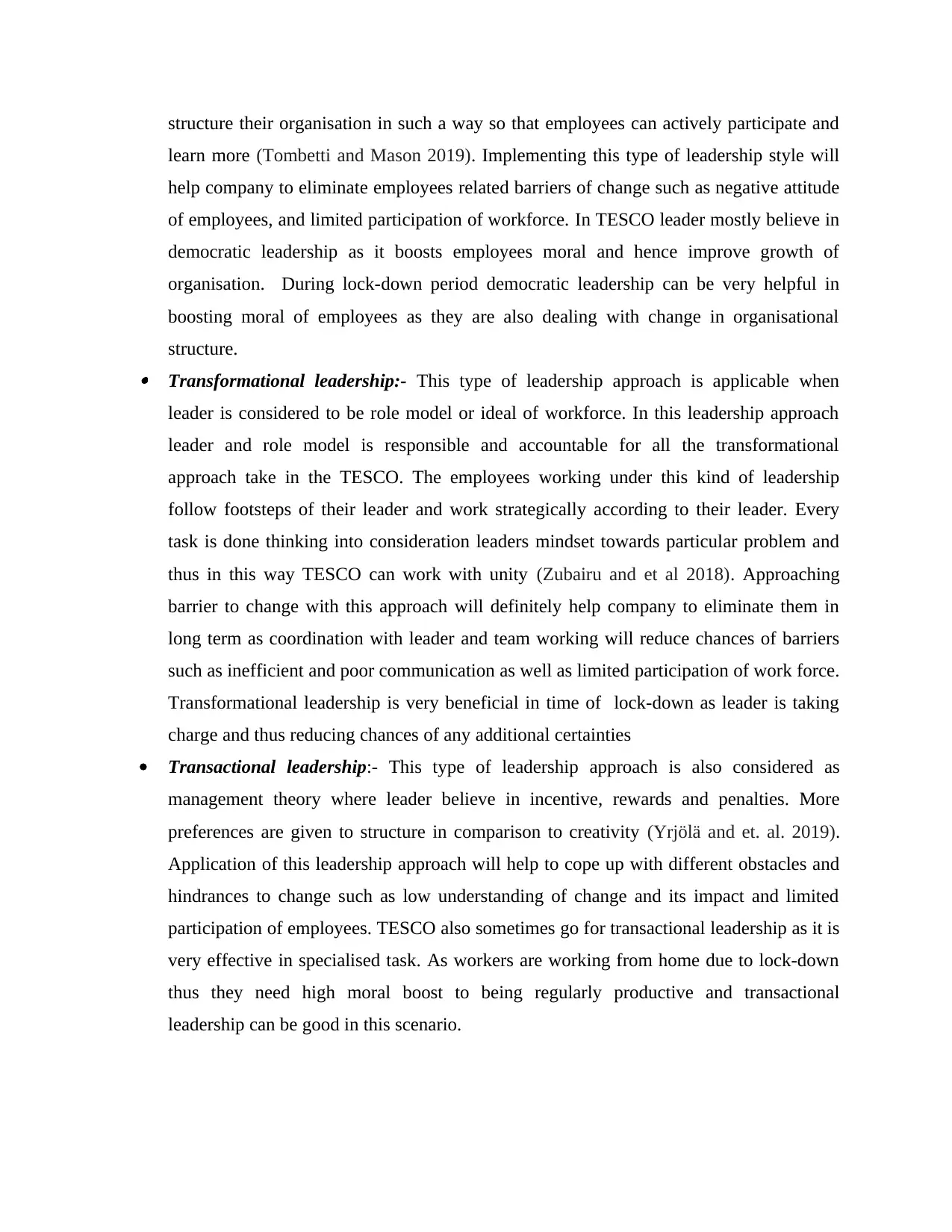
structure their organisation in such a way so that employees can actively participate and
learn more (Tombetti and Mason 2019). Implementing this type of leadership style will
help company to eliminate employees related barriers of change such as negative attitude
of employees, and limited participation of workforce. In TESCO leader mostly believe in
democratic leadership as it boosts employees moral and hence improve growth of
organisation. During lock-down period democratic leadership can be very helpful in
boosting moral of employees as they are also dealing with change in organisational
structure. Transformational leadership:- This type of leadership approach is applicable when
leader is considered to be role model or ideal of workforce. In this leadership approach
leader and role model is responsible and accountable for all the transformational
approach take in the TESCO. The employees working under this kind of leadership
follow footsteps of their leader and work strategically according to their leader. Every
task is done thinking into consideration leaders mindset towards particular problem and
thus in this way TESCO can work with unity (Zubairu and et al 2018). Approaching
barrier to change with this approach will definitely help company to eliminate them in
long term as coordination with leader and team working will reduce chances of barriers
such as inefficient and poor communication as well as limited participation of work force.
Transformational leadership is very beneficial in time of lock-down as leader is taking
charge and thus reducing chances of any additional certainties
Transactional leadership:- This type of leadership approach is also considered as
management theory where leader believe in incentive, rewards and penalties. More
preferences are given to structure in comparison to creativity (Yrjölä and et. al. 2019).
Application of this leadership approach will help to cope up with different obstacles and
hindrances to change such as low understanding of change and its impact and limited
participation of employees. TESCO also sometimes go for transactional leadership as it is
very effective in specialised task. As workers are working from home due to lock-down
thus they need high moral boost to being regularly productive and transactional
leadership can be good in this scenario.
learn more (Tombetti and Mason 2019). Implementing this type of leadership style will
help company to eliminate employees related barriers of change such as negative attitude
of employees, and limited participation of workforce. In TESCO leader mostly believe in
democratic leadership as it boosts employees moral and hence improve growth of
organisation. During lock-down period democratic leadership can be very helpful in
boosting moral of employees as they are also dealing with change in organisational
structure. Transformational leadership:- This type of leadership approach is applicable when
leader is considered to be role model or ideal of workforce. In this leadership approach
leader and role model is responsible and accountable for all the transformational
approach take in the TESCO. The employees working under this kind of leadership
follow footsteps of their leader and work strategically according to their leader. Every
task is done thinking into consideration leaders mindset towards particular problem and
thus in this way TESCO can work with unity (Zubairu and et al 2018). Approaching
barrier to change with this approach will definitely help company to eliminate them in
long term as coordination with leader and team working will reduce chances of barriers
such as inefficient and poor communication as well as limited participation of work force.
Transformational leadership is very beneficial in time of lock-down as leader is taking
charge and thus reducing chances of any additional certainties
Transactional leadership:- This type of leadership approach is also considered as
management theory where leader believe in incentive, rewards and penalties. More
preferences are given to structure in comparison to creativity (Yrjölä and et. al. 2019).
Application of this leadership approach will help to cope up with different obstacles and
hindrances to change such as low understanding of change and its impact and limited
participation of employees. TESCO also sometimes go for transactional leadership as it is
very effective in specialised task. As workers are working from home due to lock-down
thus they need high moral boost to being regularly productive and transactional
leadership can be good in this scenario.
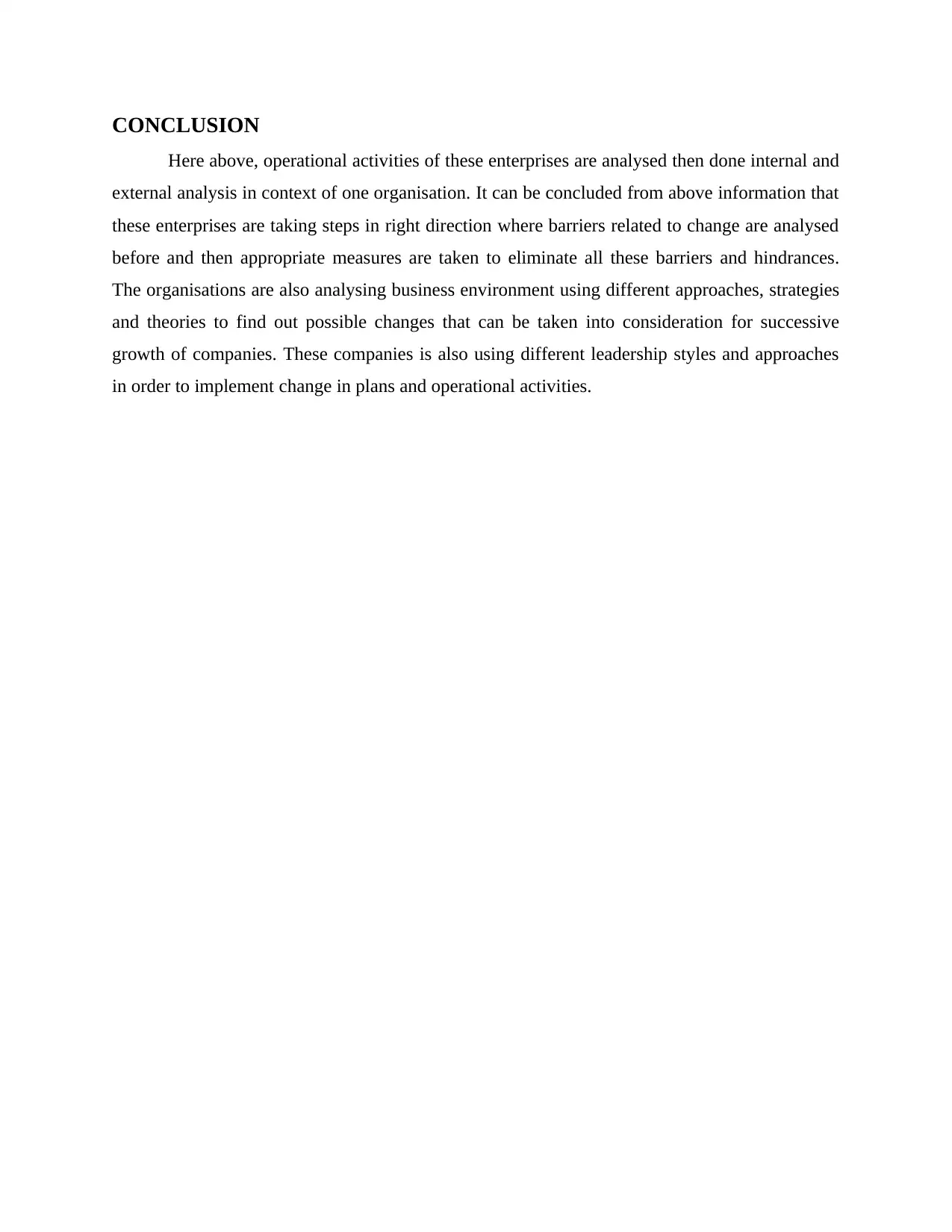
CONCLUSION
Here above, operational activities of these enterprises are analysed then done internal and
external analysis in context of one organisation. It can be concluded from above information that
these enterprises are taking steps in right direction where barriers related to change are analysed
before and then appropriate measures are taken to eliminate all these barriers and hindrances.
The organisations are also analysing business environment using different approaches, strategies
and theories to find out possible changes that can be taken into consideration for successive
growth of companies. These companies is also using different leadership styles and approaches
in order to implement change in plans and operational activities.
Here above, operational activities of these enterprises are analysed then done internal and
external analysis in context of one organisation. It can be concluded from above information that
these enterprises are taking steps in right direction where barriers related to change are analysed
before and then appropriate measures are taken to eliminate all these barriers and hindrances.
The organisations are also analysing business environment using different approaches, strategies
and theories to find out possible changes that can be taken into consideration for successive
growth of companies. These companies is also using different leadership styles and approaches
in order to implement change in plans and operational activities.
Secure Best Marks with AI Grader
Need help grading? Try our AI Grader for instant feedback on your assignments.
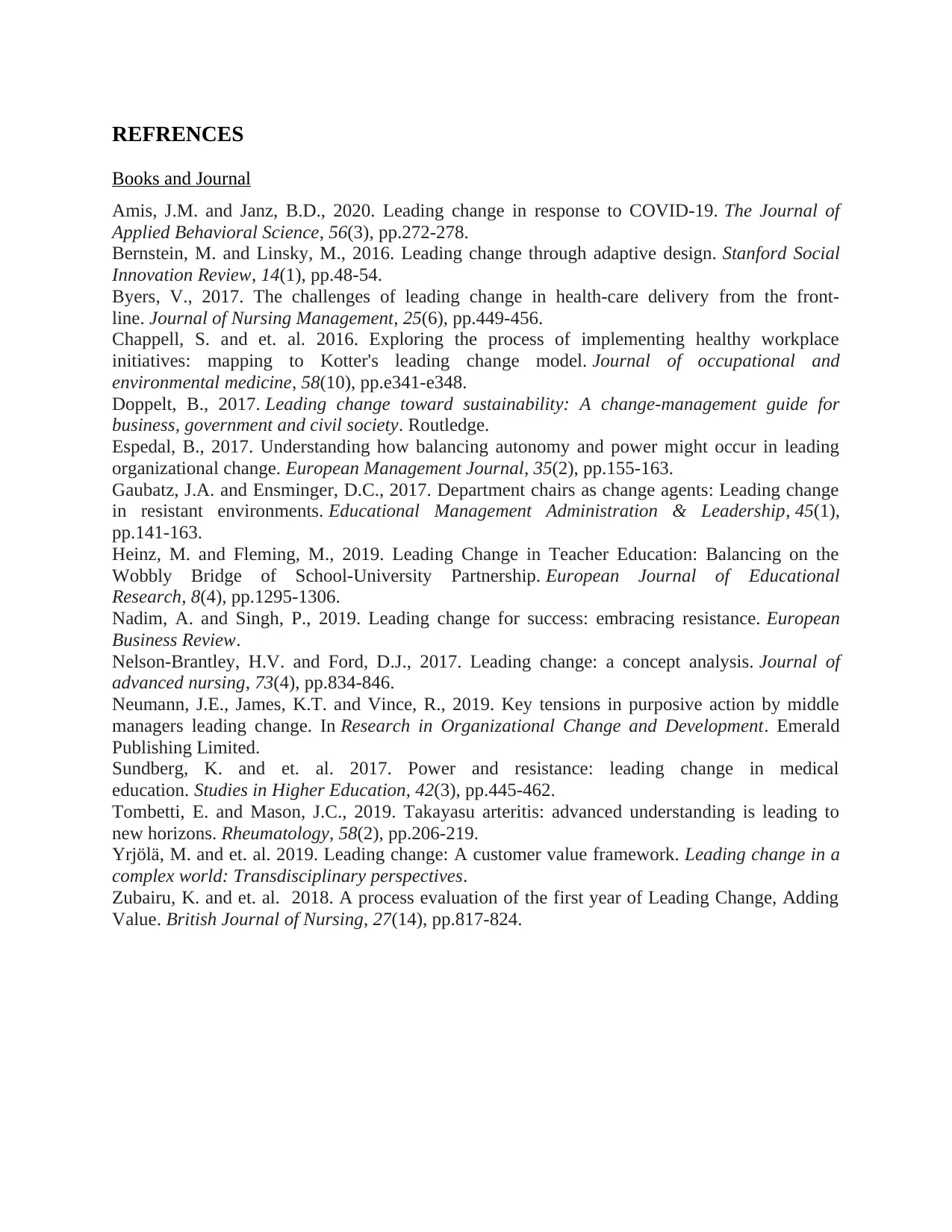
REFRENCES
Books and Journal
Amis, J.M. and Janz, B.D., 2020. Leading change in response to COVID-19. The Journal of
Applied Behavioral Science, 56(3), pp.272-278.
Bernstein, M. and Linsky, M., 2016. Leading change through adaptive design. Stanford Social
Innovation Review, 14(1), pp.48-54.
Byers, V., 2017. The challenges of leading change in health‐care delivery from the front‐
line. Journal of Nursing Management, 25(6), pp.449-456.
Chappell, S. and et. al. 2016. Exploring the process of implementing healthy workplace
initiatives: mapping to Kotter's leading change model. Journal of occupational and
environmental medicine, 58(10), pp.e341-e348.
Doppelt, B., 2017. Leading change toward sustainability: A change-management guide for
business, government and civil society. Routledge.
Espedal, B., 2017. Understanding how balancing autonomy and power might occur in leading
organizational change. European Management Journal, 35(2), pp.155-163.
Gaubatz, J.A. and Ensminger, D.C., 2017. Department chairs as change agents: Leading change
in resistant environments. Educational Management Administration & Leadership, 45(1),
pp.141-163.
Heinz, M. and Fleming, M., 2019. Leading Change in Teacher Education: Balancing on the
Wobbly Bridge of School-University Partnership. European Journal of Educational
Research, 8(4), pp.1295-1306.
Nadim, A. and Singh, P., 2019. Leading change for success: embracing resistance. European
Business Review.
Nelson‐Brantley, H.V. and Ford, D.J., 2017. Leading change: a concept analysis. Journal of
advanced nursing, 73(4), pp.834-846.
Neumann, J.E., James, K.T. and Vince, R., 2019. Key tensions in purposive action by middle
managers leading change. In Research in Organizational Change and Development. Emerald
Publishing Limited.
Sundberg, K. and et. al. 2017. Power and resistance: leading change in medical
education. Studies in Higher Education, 42(3), pp.445-462.
Tombetti, E. and Mason, J.C., 2019. Takayasu arteritis: advanced understanding is leading to
new horizons. Rheumatology, 58(2), pp.206-219.
Yrjölä, M. and et. al. 2019. Leading change: A customer value framework. Leading change in a
complex world: Transdisciplinary perspectives.
Zubairu, K. and et. al. 2018. A process evaluation of the first year of Leading Change, Adding
Value. British Journal of Nursing, 27(14), pp.817-824.
Books and Journal
Amis, J.M. and Janz, B.D., 2020. Leading change in response to COVID-19. The Journal of
Applied Behavioral Science, 56(3), pp.272-278.
Bernstein, M. and Linsky, M., 2016. Leading change through adaptive design. Stanford Social
Innovation Review, 14(1), pp.48-54.
Byers, V., 2017. The challenges of leading change in health‐care delivery from the front‐
line. Journal of Nursing Management, 25(6), pp.449-456.
Chappell, S. and et. al. 2016. Exploring the process of implementing healthy workplace
initiatives: mapping to Kotter's leading change model. Journal of occupational and
environmental medicine, 58(10), pp.e341-e348.
Doppelt, B., 2017. Leading change toward sustainability: A change-management guide for
business, government and civil society. Routledge.
Espedal, B., 2017. Understanding how balancing autonomy and power might occur in leading
organizational change. European Management Journal, 35(2), pp.155-163.
Gaubatz, J.A. and Ensminger, D.C., 2017. Department chairs as change agents: Leading change
in resistant environments. Educational Management Administration & Leadership, 45(1),
pp.141-163.
Heinz, M. and Fleming, M., 2019. Leading Change in Teacher Education: Balancing on the
Wobbly Bridge of School-University Partnership. European Journal of Educational
Research, 8(4), pp.1295-1306.
Nadim, A. and Singh, P., 2019. Leading change for success: embracing resistance. European
Business Review.
Nelson‐Brantley, H.V. and Ford, D.J., 2017. Leading change: a concept analysis. Journal of
advanced nursing, 73(4), pp.834-846.
Neumann, J.E., James, K.T. and Vince, R., 2019. Key tensions in purposive action by middle
managers leading change. In Research in Organizational Change and Development. Emerald
Publishing Limited.
Sundberg, K. and et. al. 2017. Power and resistance: leading change in medical
education. Studies in Higher Education, 42(3), pp.445-462.
Tombetti, E. and Mason, J.C., 2019. Takayasu arteritis: advanced understanding is leading to
new horizons. Rheumatology, 58(2), pp.206-219.
Yrjölä, M. and et. al. 2019. Leading change: A customer value framework. Leading change in a
complex world: Transdisciplinary perspectives.
Zubairu, K. and et. al. 2018. A process evaluation of the first year of Leading Change, Adding
Value. British Journal of Nursing, 27(14), pp.817-824.
1 out of 17
Related Documents
Your All-in-One AI-Powered Toolkit for Academic Success.
+13062052269
info@desklib.com
Available 24*7 on WhatsApp / Email
![[object Object]](/_next/static/media/star-bottom.7253800d.svg)
Unlock your academic potential
© 2024 | Zucol Services PVT LTD | All rights reserved.





